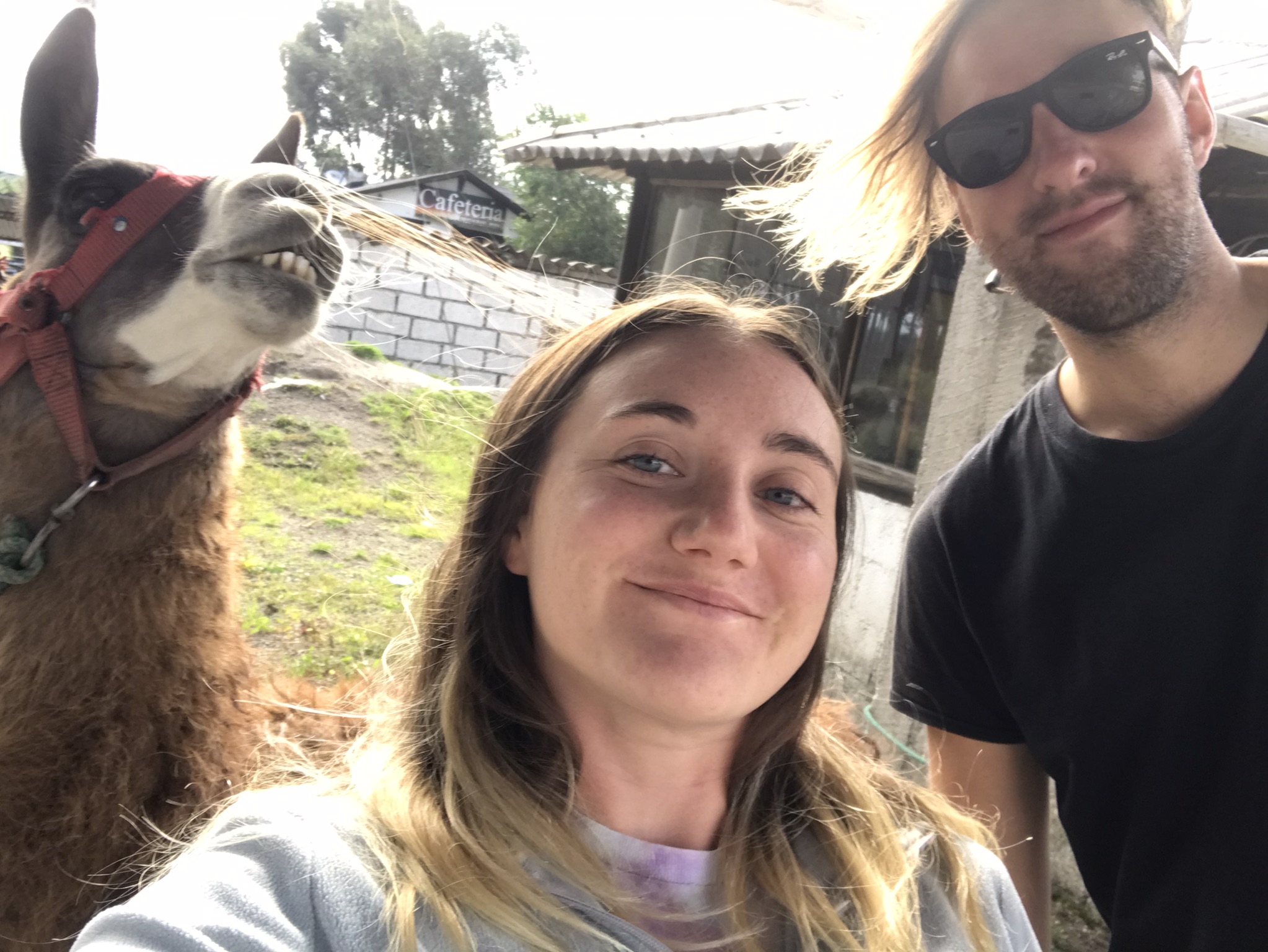With mountains, jungles, beaches, colonial cities and a strong indigenous culture, Ecuador has plenty to offer. Read on for my honest experiences and opinions on Ecuador travel!
Otavalo, Quito, Banos, Riobamba, Cuenca, Guayaquil, Galapagos Islands
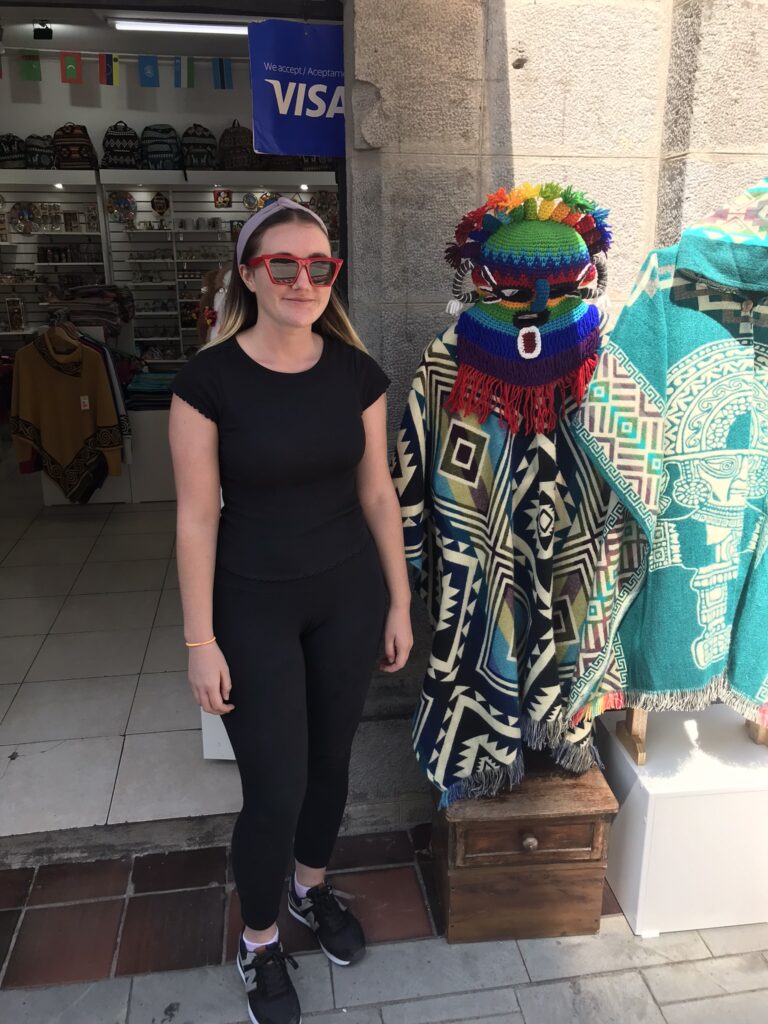
Aya Huma mask – used in traditional rituals and celebrations
Land of volcanoes, condors and our first point of contact with the Andean belief system. Here there is distinct fusion in art and architecture between popular Andean beliefs and the colonial Catholic establishment. When the Spanish conquistadors arrived, they forced their Catholic religion on the indigenous population and attempted to Christianise them, however you can still see unorthodox twists such as ears of corn on the façade of churches, traditional Incan dress or local cuisine such as chicha or guinea pigs in religious paintings and in the artefacts produced by indigenous hands. We were fascinated by their folk festivals which are a relic of traditional Andean belief featuring garish, almost cartoonish masked characters with symbolic meaning. Ecuador, Peru and Bolivia all share Andean belief systems.
Ecuador uses U.S. dollars as their national currency, however they do have Ecuadorian $1 coins which are worthless, except for sentimental value, outside of the country. Stock up on dollars in Ecuador, especially if you’re heading to Argentina afterwards.
Fee free ATM: Banco Internacional
Uber works! However the frequency of drivers isn’t always great compared to some neighbouring countries, we struggled quite a few times to get an Uber in the centre of Quito
Travel
Ecuador was one of the only countries in South America where we literally had to turn up at the bus station and book tickets there. Buses are quite frequent between most cities but it wasn’t possible to pre-book tickets or even easily find out bus times in many cases. I would definitely recommend booking onward bus travel to you next destination when you’ve just arrived at the bus station, as that way you will know what time the buses are and it avoids having to go to the bus station again the day before. Expect VERY winding, mountainous roads here, this combined with the altitude makes for a fun ride!
Safety
We never felt unsafe or in danger in Ecuador, much to other people’s surprise (even my mum was worried about me visiting Ecuador for some reason). We walked around Otavalo, the historic centre of Quito, Riobamba, Cuenca and Banos at night without any problems. The only exception to this was Guayquail, where we only ventured as far as the Malecon where we liked the obvious police presence and lack of harassment from street sellers. The difference between Colombia and Ecuador was tangible to us, we felt much more comfortable and less on edge in Ecuador but maybe we’d just relaxed more. Outside of Guayaquil, which does have a bad reputation, Ecuador travel seemed relatively safe to us. We were approached by police in Quito warning us to keep an eye on our belongings but we weren’t surprised or shaken by this at all, thefts are common in all busy, touristy areas in South America; crime is a fact of life here! Reduce the risk of being targeted by thieves by never flashing fancy items or cameras, never leaving your phone or wallet in your back pocket or holding your phone far away from your body i.e. to take selfies without first checking your surroundings, leaving your phone on the table at a restaurant, leaving your backpack in an easily reachable place or unattended and just be aware of any suspect characters nearby. We used ‘the money bag’, as we nicknamed it, to carry cash. It’s a cash pouch on a necklace which you can hide beneath your clothes, it rests on the middle of your chest.
Altitude Sickness
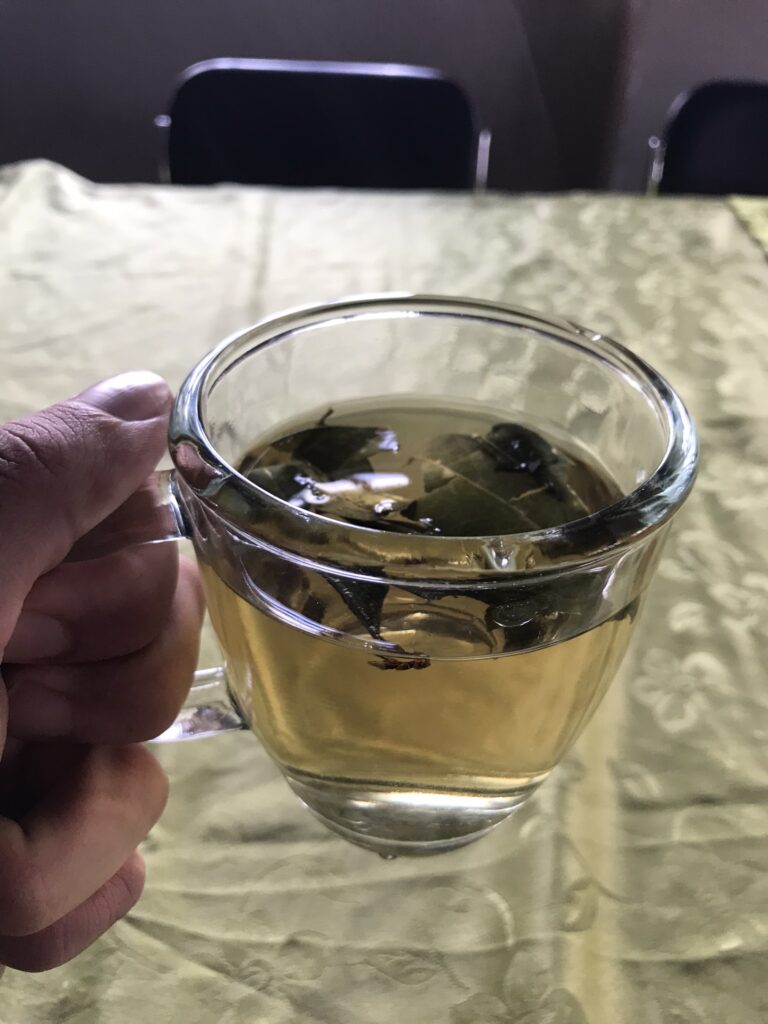
Coca tea – the most widely used herbal remedy against altitude sickness
We were very lucky during our trip that we did not experience any serious altitude sickness side-effects. However, we chose to travel slowly by bus from place to place, meaning a more gradual ascent and therefore more likely to prevent altitude sickness. You may experience headaches, nausea, light-headedness, tiredness or shortness of breath if not properly acclimatized like us. We most certainly felt short of breath when climbing stairs or hills but these things are unavoidable, especially at cheap hostels and walking to and from bus stations! It was only in northern Peru that we felt the effects of the altitude more directly. We made preparations before we came to South America to combat altitude sickness, a Peruvian couple that we’d randomly met previously in Egypt had recommended that we take chlorophyll supplements for a couple of weeks/months before getting to high altitude, chlorophyll is the green pigment in plants which helps with absorbing oxygen and you can purchase this easily from most pharmacies or online. This seemed to work for us, but we don’t know if it was the chlorophyll or just that we’d acclimatized. Coca tea is a herbal remedy often used by locals and tourists to combat the side-effects of altitude sickness, coca leaves are absolutely everywhere in Ecuador, Peru and Bolivia (the alto-plano) but most commonly found in markets.
Otavalo
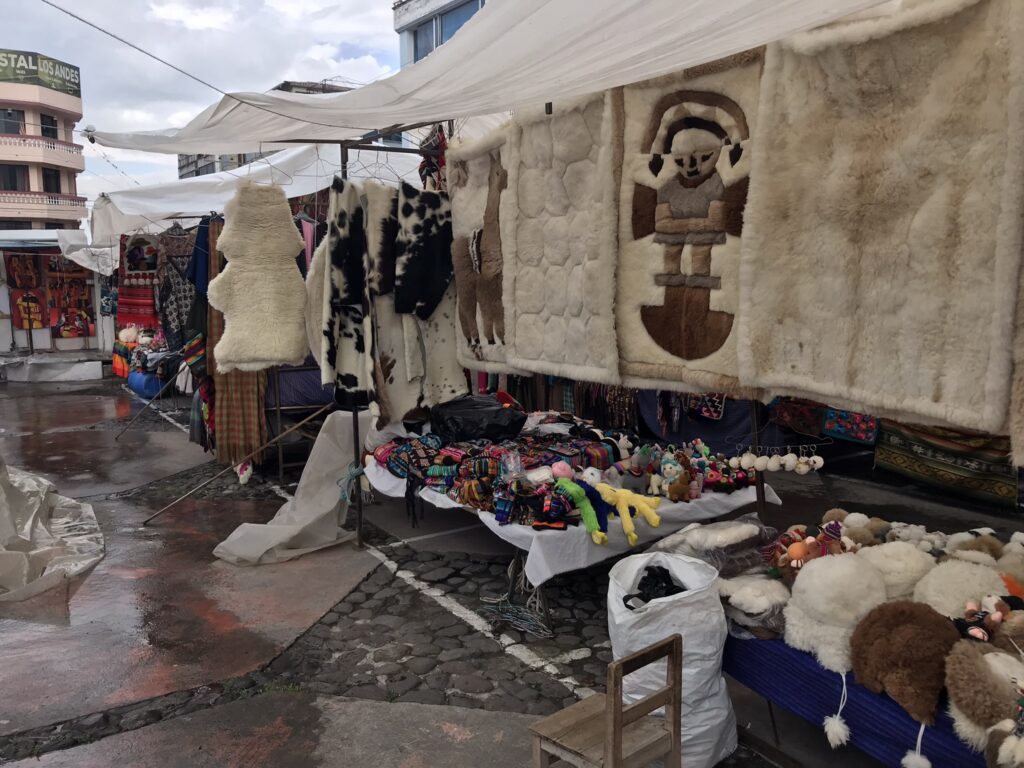
Otavalo is well-known for its large indigenous market, here you can purchase alpaca-fur products and other handicrafts
When first arriving in a country and landing in the capital city it often feels so samey, it’s often difficult to differentiate between one huge concrete city and another. Most have similar traffic problems, faceless high-rise buildings, pigeons perched on the heads of once-grand statues now covered in pigeon shit and businessmen dashing around. That’s why we always prefer to start exploring a country by first visiting a smaller town to get our bearings. You can easily get swallowed up in a vast city-scape. Otavalo provided a perfect resting place after the painful border crossing from Colombia. We took the bus directly from Tulcan near the border to Quito, jumping out at the side of the road near the centre of Otavalo.
Otavalo is famous for its indigenous market and is known as an ‘indigenous city’. You will see plenty of indigenous men with long ponytails and women in traditional dress. Otavalo is a relaxed town with a slow pace of life, which was a welcome relief after our time in high-energy Colombia. There are several volcanoes in the region that you can easily visit, however we just took a few days to chill out here.
Accommodation
Hostal la Rosa Otavalo – highly recommend! A large spacious room and decent breakfast
Foodie Places
- YANNUK – the savory pancakes are to die for!
- Balcon De Imbabura – lovely little Mexican restaurant, we had the burritos and they were huge!
Activities
- Browsing the indigenous market – it’s always a slightly awkward experience for me, being British, to visit a touristy craft market as I know I don’t really want to buy anything and I also cannot fit anything big in my bag. I also don’t like being approached by sellers under those conditions as I feel like I’m wasting their time or I feel obliged to buy something, both scenarios I try to avoid. But you can have a look at the market from a distance like we did or a brisk walk through the stalls. The market runs every day at Plaza del Poncho but on Saturdays it expands to take over most of the city centre.
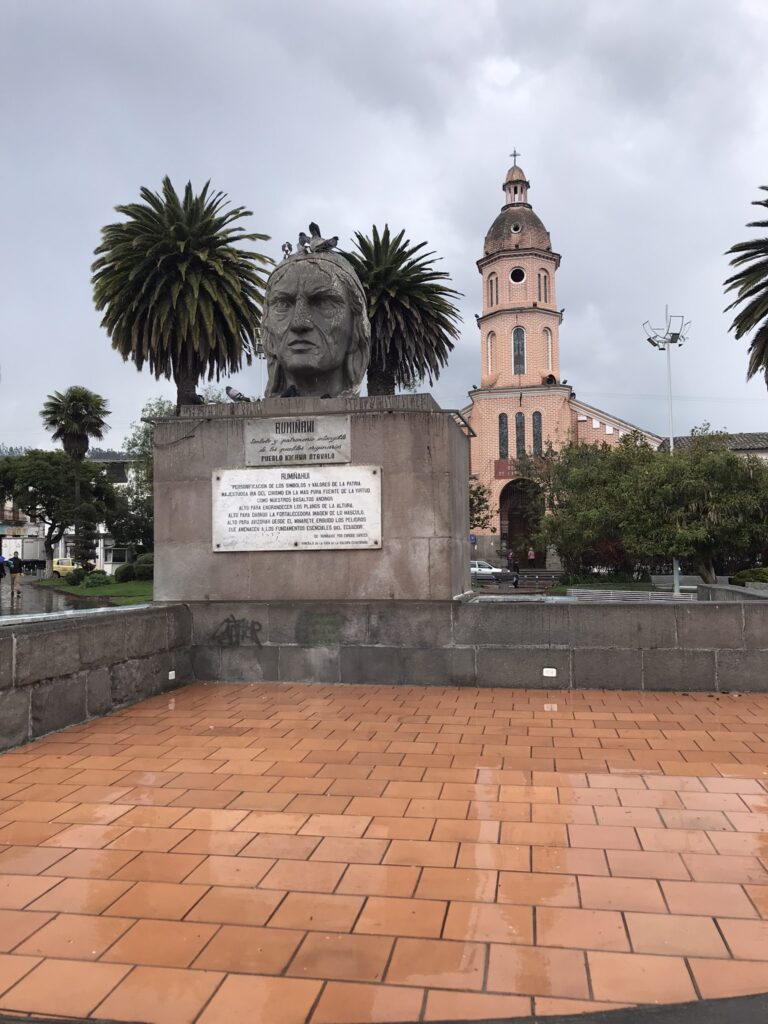
A statute of the indigenous leader Ruminawi
- Wandering around the town centre – there are a few churches and plazas that can mostly been seen in a couple of hours. The churches are illuminated at night which can be quite pretty
Quito
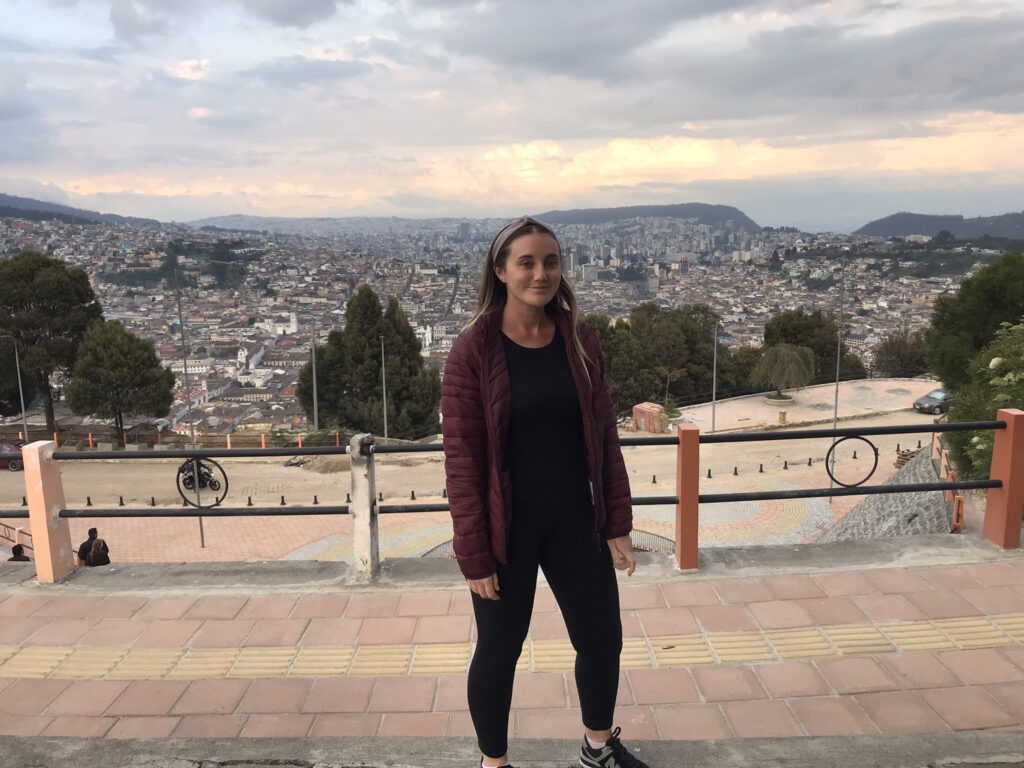
Sunset at the Virgin of the Panecillo, Quito
In Colombia we lived like proverbial kings, dining out for all of our meals. We found Ecuador, especially Quito, to be a tad more expensive for eating out, so we resigned ourselves to cooking more meals to save money. I’m not sure if this is because we became a bit spoiled for cheap food in Colombia, or using dollars psychologically made us think everything was more expensive.
We stayed for almost a week in Quito as there is quite a lot to see and do here, both in the city itself and nearby
Accommodation
Hostel Rebel – helpful hostel staff with a kitchen, located close to the historic centre, it’s good for exploring the area but quiet at night-time, there’s not really a party scene here.
Foodie Places
- Fabiolita – located opposite the Secretaria General de Coordinacion Territorial y Particopacion Ciudadana on google maps, I cannot recommend the pernil sandwich combo with Jamaica (pronounced Ham-aica) enough, it cost us $2.50 and was fab! We ate there about 3 times.
- Centro Comercial Palacio Arzobispal – lovely historic venue with restaurants and cafes inside, we watched a match of Ecuador in the World Cup here, too many beers were consumed it’s safe to say.
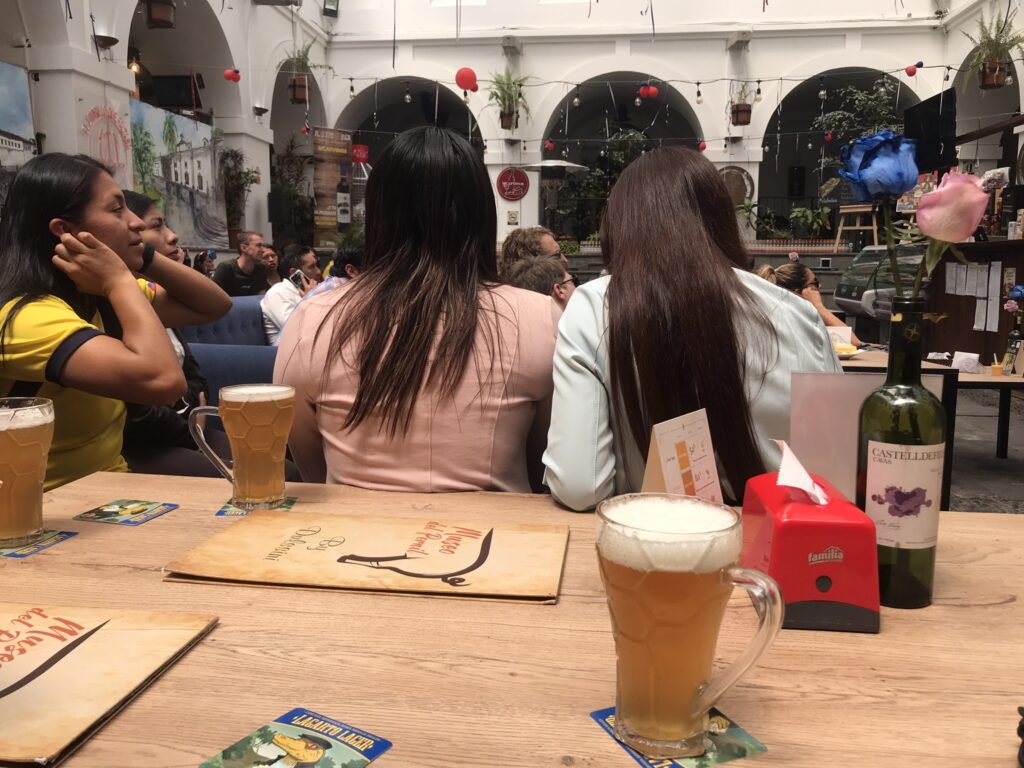
Watching Ecuador get knocked out of the world cup
- Dulce Jesus Mio Heladeria Artesanal – we were taken here on our walking tour and treated to free samples of ice cream with flavours like pina-colada, coconut rum, cheese (crazy I know!) and many other sorbets.
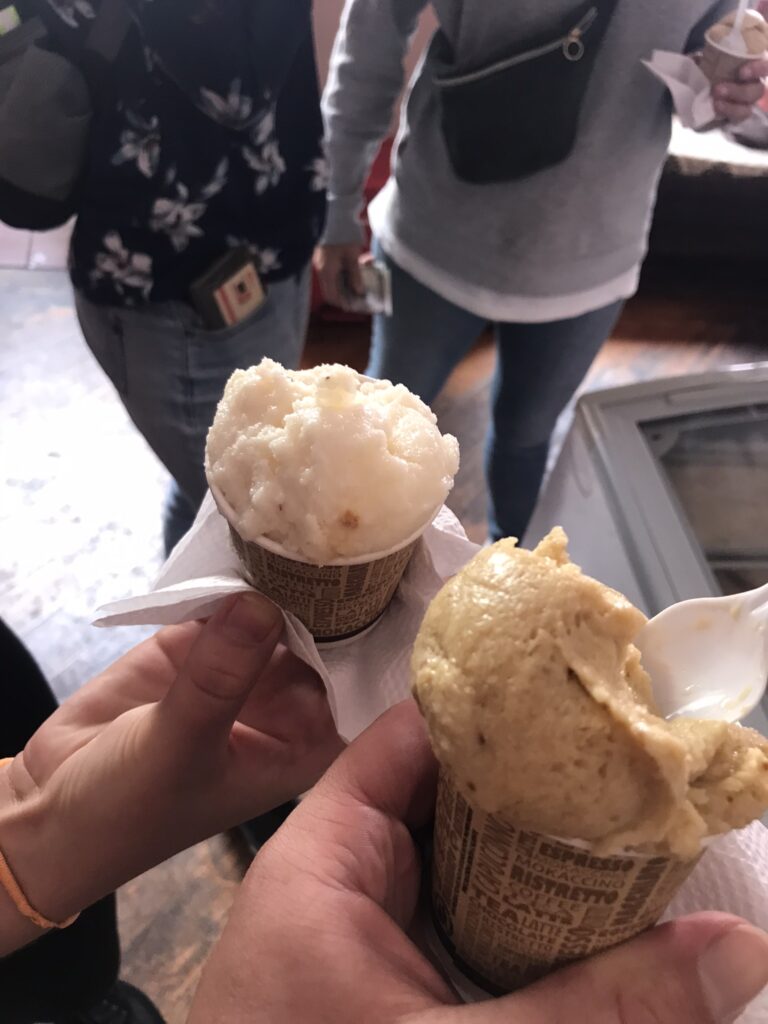
A different take on ice-cream
- Yumbos Chocolate – again our walking tour happened to stop here for a free chocolate tasting, can’t say I was annoyed! Great views of San Francisco church and square.
Activities
- City walking tour booked through Guruwalk – visiting many churches along the seven crosses route
- Cotopaxi and Quilotoa day trip – many people visit Cotopaxi and Quilotoa separately on day trips or stay overnight, however we found it was cheaper to visit both in one day on a group tour from Quito, this meant a lot of travel time but was worth it if you’re on a tight schedule. It was a whistlestop tour that saw all the main sites, we didn’t feel like we were rushed or missed anything however you may want to consider staying the night somewhere and spending a day to explore each place if you are a serious hiker and want to walk the loop around the volcano or crater
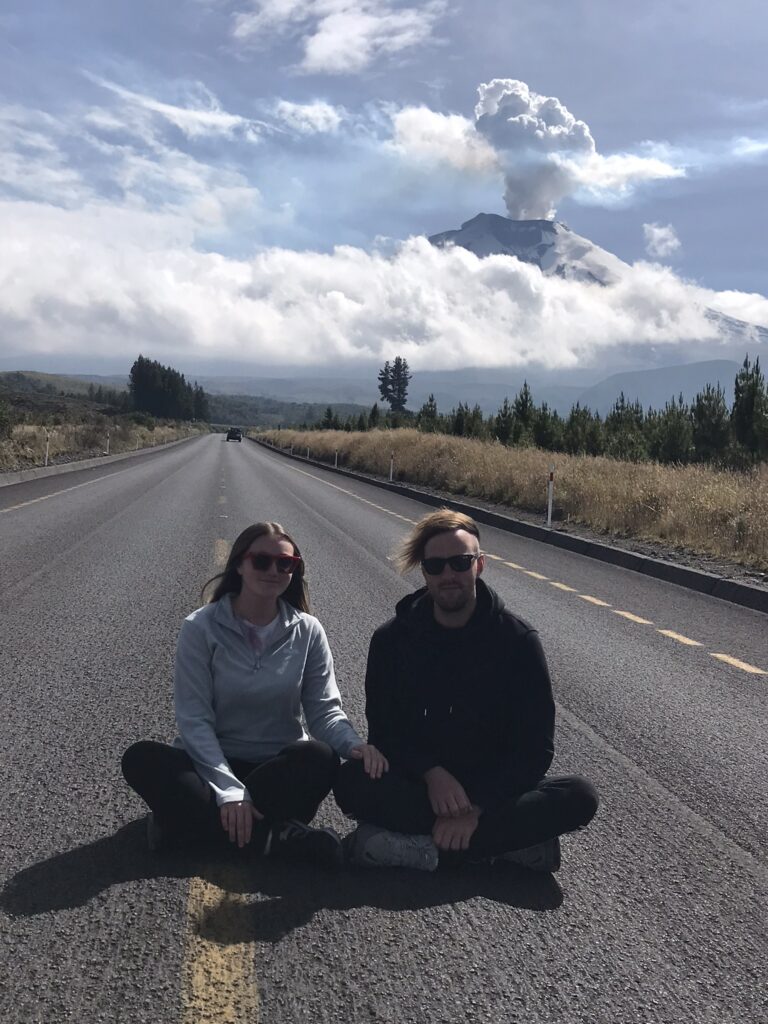
In the shadow of Cotopaxi volcano
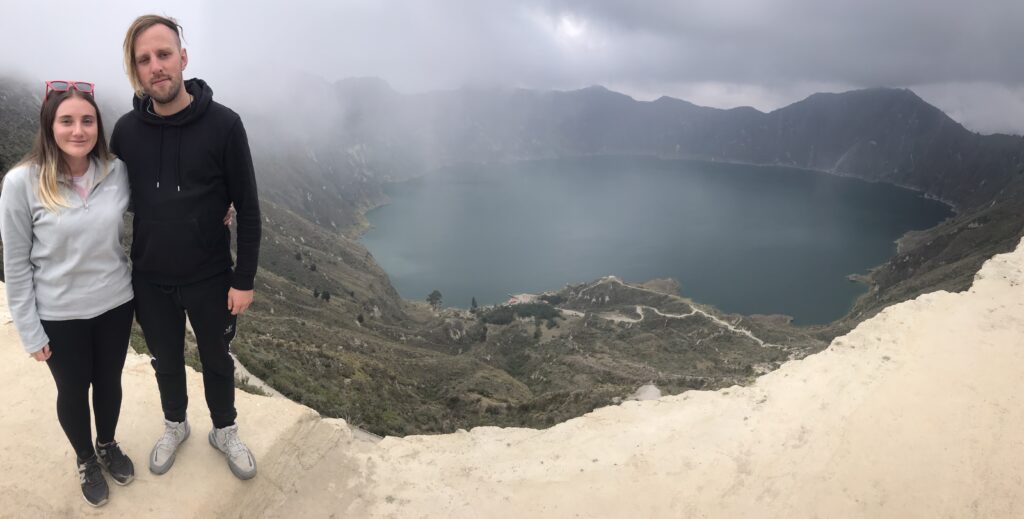
Quilotoa crater – we decided against walking to the water’s edge as the uphill trek back would’ve killed us
- Virgin of the Panecillo – I actually preferred this monument to Christ the Redeemer in Rio, not only was it free to visit but there weren’t hordes of tourists barging into your photo, it’s great to visit at sunset but make sure you get an Uber or taxi to the summit and back to your hostel as we were told the surrounding area is dangerous, it’s not advisable to walk up to the top even during the day. Make sure you have a way back down too – we didn’t, but thankfully there was a lone taxi hanging around or we would’ve been stuck.
- We splurged on quite a few museums: Museo de Arte Colonial, Museum of the City and Pre-Columbian Art Museum
- Mitad del Mundo and Museo de Sitio Intiñan – we jumped in an Uber for the short ride to these novelty attrations at the equator. We found Mitad del Mundo to be okay, it’s well known for the huge compass monument. My favourite part was the display of indigenous clothing, customs and festivals inside the monument itself. Intiñan was a lot more interactive with dramatic experiments to show the effects of the equator on solids and liquids, there was even a real-life willy fish and shrunken head on display so watch out for those!

On display at Museo de Sitio Intiñan: a willy fish and shrunken head
- We stumbled into quite a few impromptu parades whilst in Quito, one consisted of clowns dancing in a square. I’m not sure what the meaning of this was, still a bit mystified.
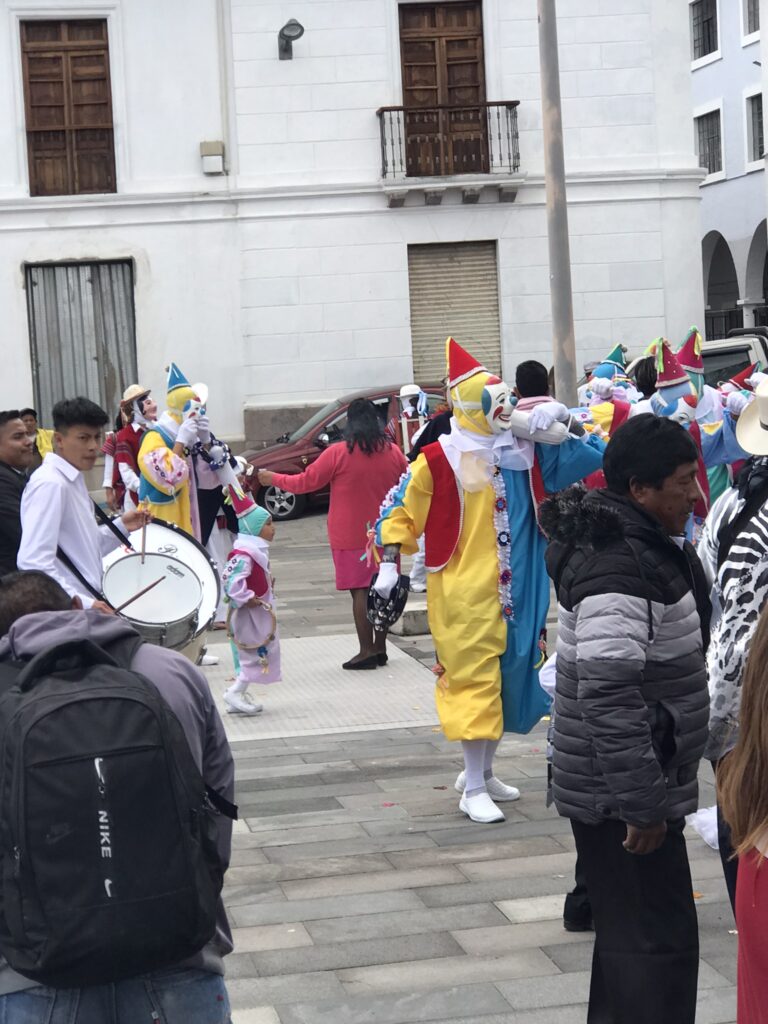
Not sure if this is a dream or nightmare
- Capilla del Hombre- A monument to the work of the artist Guayasamin. The easiest way to get here is by Uber. If dark, tormented and anguished art is your thing, check it out, I highly recommend a visit! The ticket to this complex also includes entrance to Guayasamin’s house and workshop. At both the Capilla del Hombre and house there are free guided tours in English.
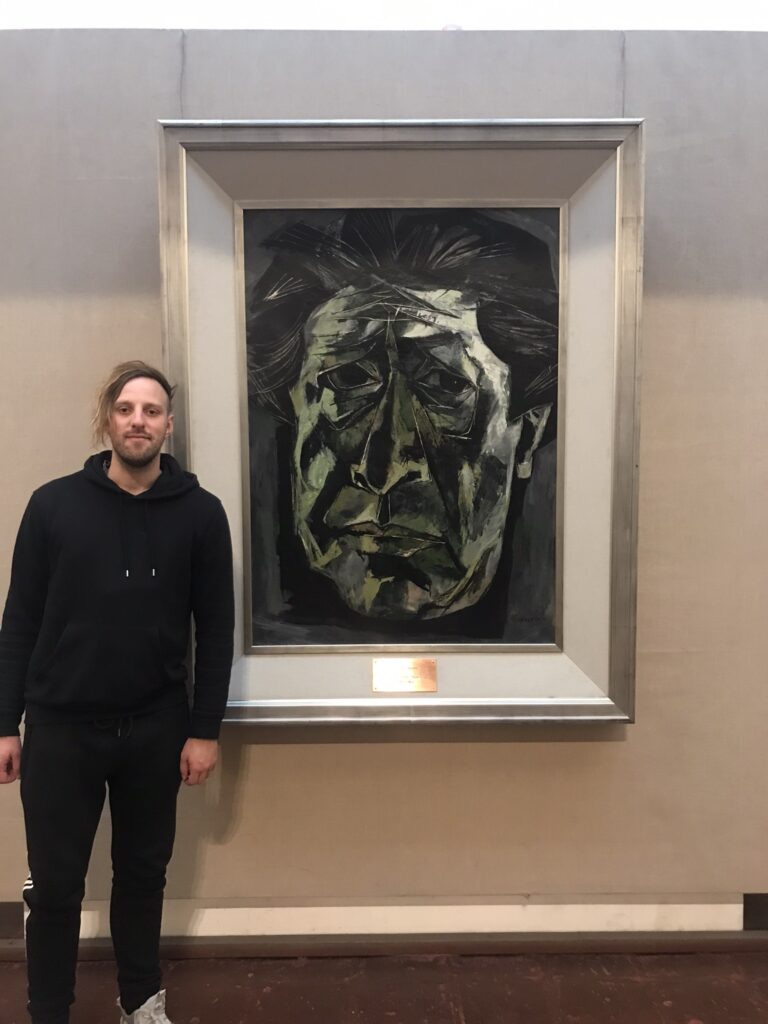
Dan and Guayasamin
- TelefériQo Cable Car to Pichincha volcano – the views weren’t as spectacular as we expected as it was cloudy but nevertheless a nice mountain-side walk. There are several trails you can follow at the top and a swing which makes for a dramatic photo op.
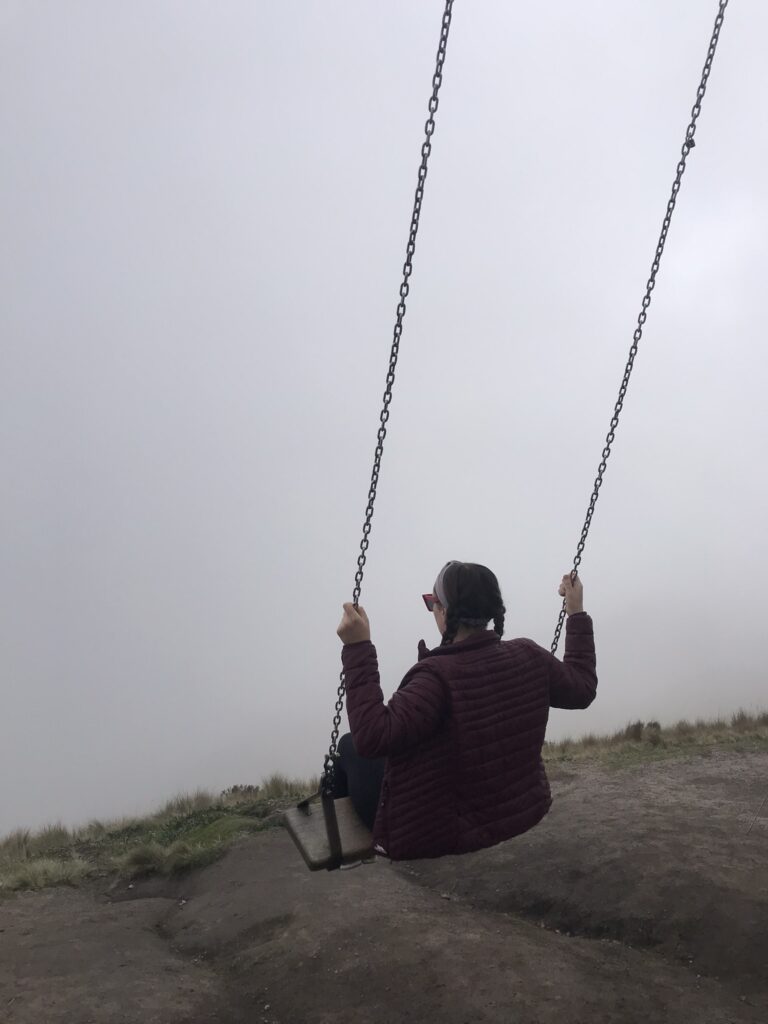
Banos
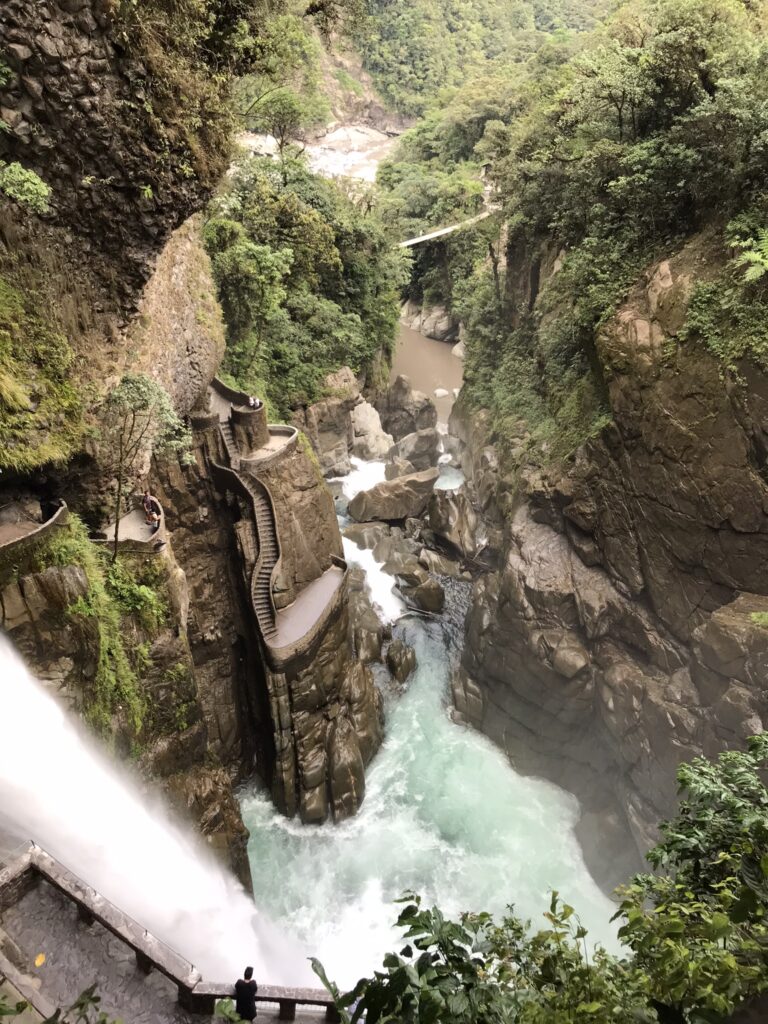
One of the many waterfalls near Banos – a lot of people choose to cycle to the waterfalls
Banos, is a quaint town located in the Andean mountains. It’s surrounded by many volcanos and waterfalls but best-known for its public thermal baths, hence the name. Banos has something for everyone, and I mean everyone, from biking to all the nearby waterfalls, to white-water rafting, to luxury spa retreats, public thermal baths and horse-riding around the lush, green mountainside (guilty!). Passing backpackers had spread the word to us that Banos was well worth a visit, so naturally we had to see what all the fuss was about, and I’ll let you into a secret – we weren’t disappointed!
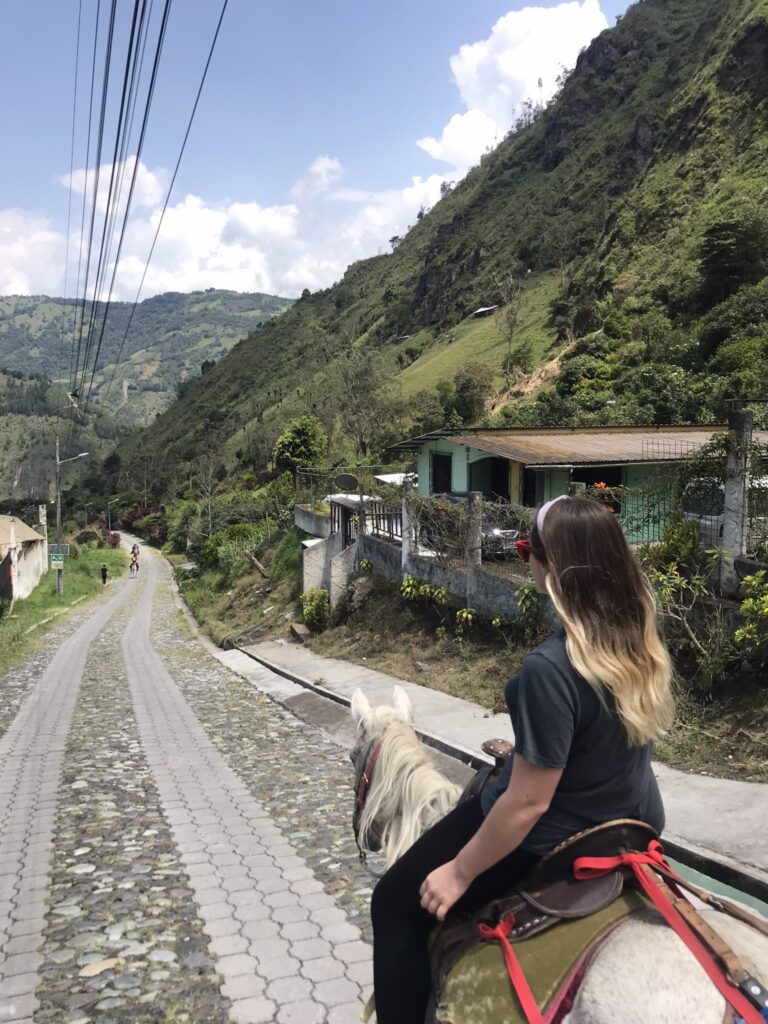
A birthday treat – horse-riding in Banos
Accommodation
- Hostal La Casa del Molino Blanco – nice place but required a bit of uphill walking to get there from the town centre.
- Hotel de mi Pueblo – a more expensive, high-end hotel where we spent a night for my birthday
Foodie Places
- Sher E Punjab Rincon de la India – 2nd best Indian-style curry I had in South America. The garlic naan is amazing and so is the lamb rogan josh.
- Restaurante México de mis Sabores – popular spot for Mexican food
- Aromi cafe – sells local coffee and products
- La Tasca de Baños – great tapas, we went here for my birthday.
Activities
- Waterfall tour by bus- this seemed more like a party bus for Ecuadorian tourists but we did get to see the most iconic waterfalls.
- Puyo visit – jungle walk, visit to indigenous village with welcome dance from villagers and children, face painted, complimentary drink of something, Dan shot a dart using a blow dart, a man tried to make us eat a witchey-grub but no one wanted to, you could have your photo taken with a snake or parrot. I’m not 100% convinced that the experience was genuine, it felt a bit artificial, catering for tourists to visit.
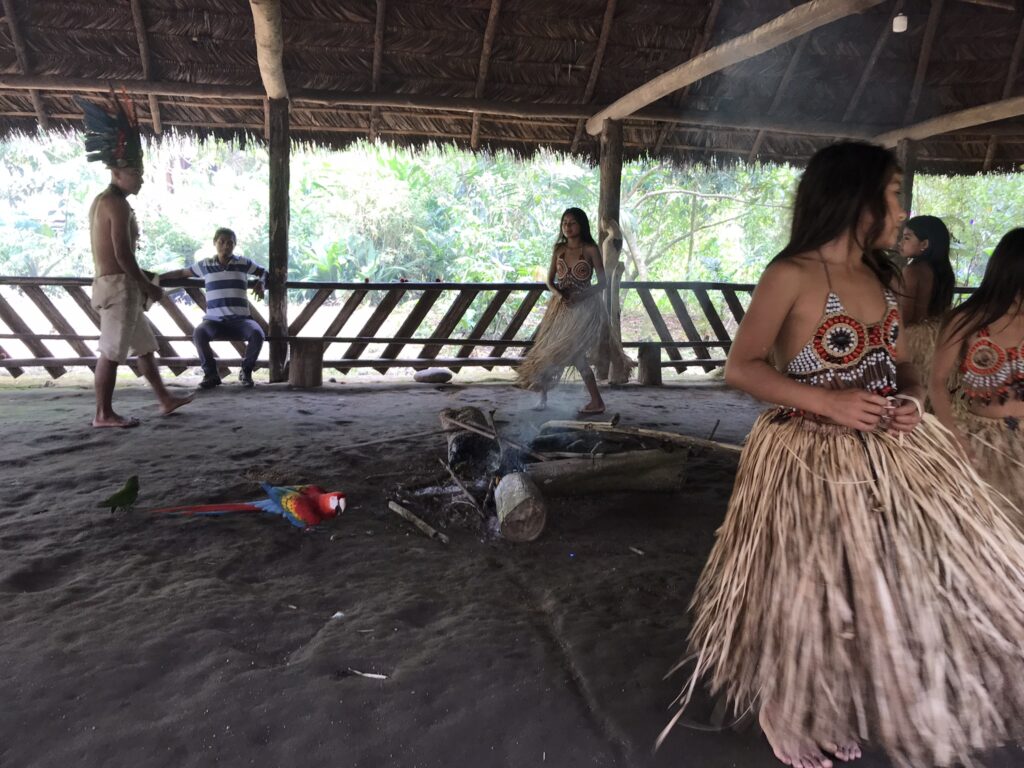
We were treated to a traditional dance by a local indigenous community on the Puyo Jungle tour
- Horse-riding – our horses tried to race uphill, they were super competitive.
- Being hand-delivered a cake by the lady who owns Hotel de mi Pueblo while in the nude. I’d been so excited to see a spa bath, I immediately jumped into it and was lounging around afterwards nude. There was a knock at the door, Dan answered it as I hid in the bathroom, Dan tried to coax me to come out. That was how I received a serenade of ‘feliz cumpleanos’ and a cake whilst in the nude.
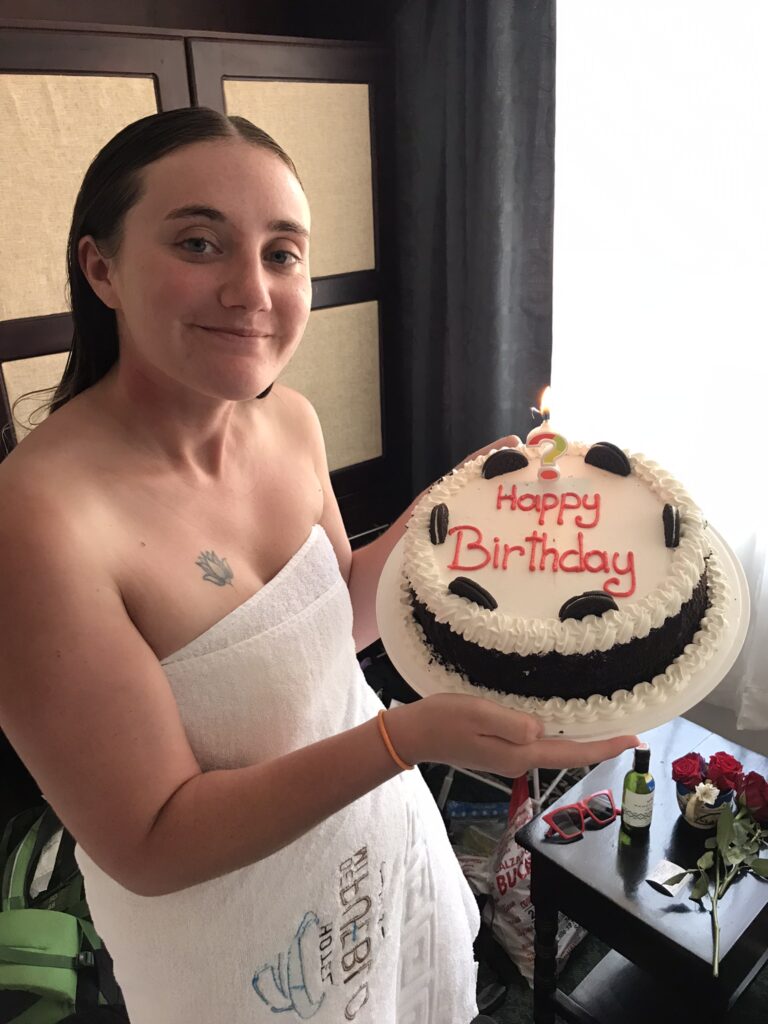
A very unexpected birthday surprise
- Spa day – this was booked through the Hotel de mi Pueblo as a birthday treat, great prices for spa treatments, I can assure you that the full body massage really does mean full-body. This was my first full-body massage and I’m convinced the masseuse saw pretty much everything. The hotel we stayed in let us use their sister hotel for spa facilities and swimming pool
- White-water rafting – Grade 4 and 5 rapids, pretty intense experience.
Riobamba
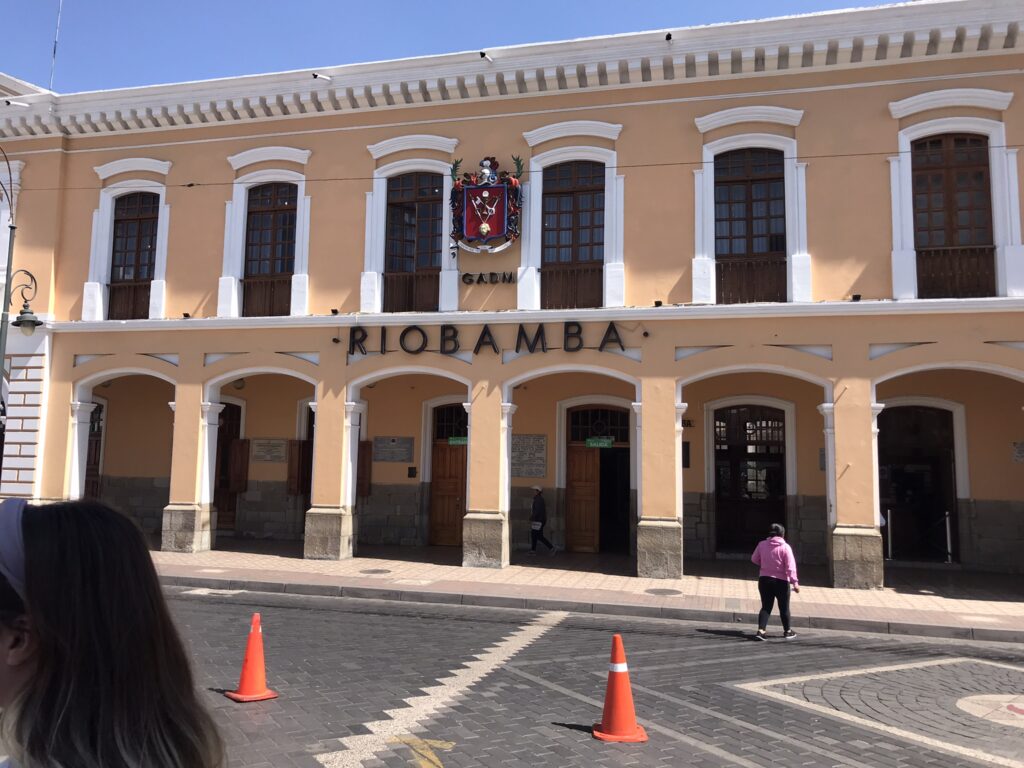
An unassuming, normal Ecuadorian town, not yet invaded by hordes of tourists or little ant-people wearing huge backpacks. Most people who do make it here are visiting Mt Chimborazo, Ecuador’s highest mountain which dominates the city skyline. Because of its location near to the equator, Chimborazo is technically the highest point on earth (as in the furthest point away from the planet’s core). You can also see the old railway station in Riobamba, which has been turned into a cafe and market area following the collapse of Ecuador’s rail industry.
Accommodation
Villa Bonita Hostel – comfortable old building and one of the only hostels in town, full of people preparing to trek on Chimborazo. They helped us to arrange our trip to the volcano.
Foodie Places
- Taco Naco – hands down best quesadilla I’ve had outside of Mexico and I became a bit of a quesadilla snob during my time, we were also featured on their instagram feed!
- Casa Rubio “Cayfrut’s” – we really enjoyed the food and atmosphere.
- Dolce Latto – we stumbled upon this place when trying to find our hostel, super cheap sandwiches and waffles.
Activities
- A self-guided city tour including Mercado La Merced, Museo de la ciudad (which has free entry and features an exhibition of interesting local artists) and Parque 21 De Abril. We enjoyed the boistrous serving ladies calling out to us in the mercado and had a juice with some ice from the nearby volcano.
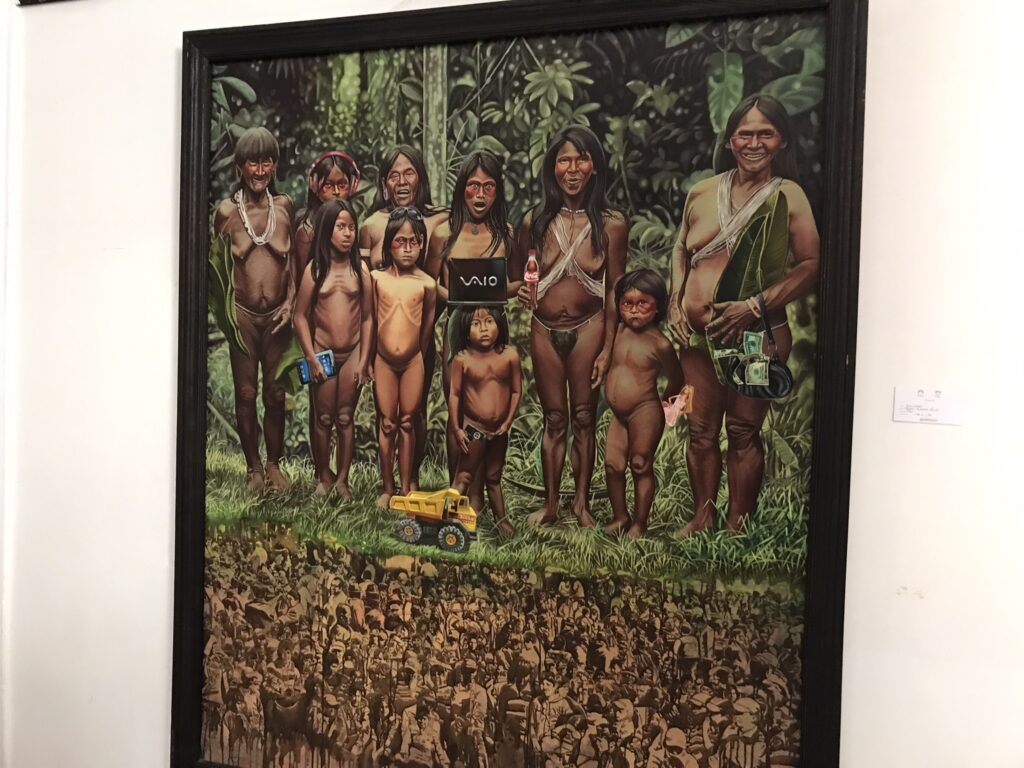
I was particularly drawn to this piece in the Museum
- We took the cheat way up Chimborazo volcano on horse-back, however most people choose to share a taxi to the base camp and trek the rest of the way up to Concha Condor 5100m above sea level. We arranged the horse-riding trek through our hostel, our guide mentioned that it’s possible to snowboard on the side of Chimborazo however as I’ve only ever skied I decided this was a bad idea, especially with no guard rails or ski-lift – this guy and his friends carried their own boards up the mountain!
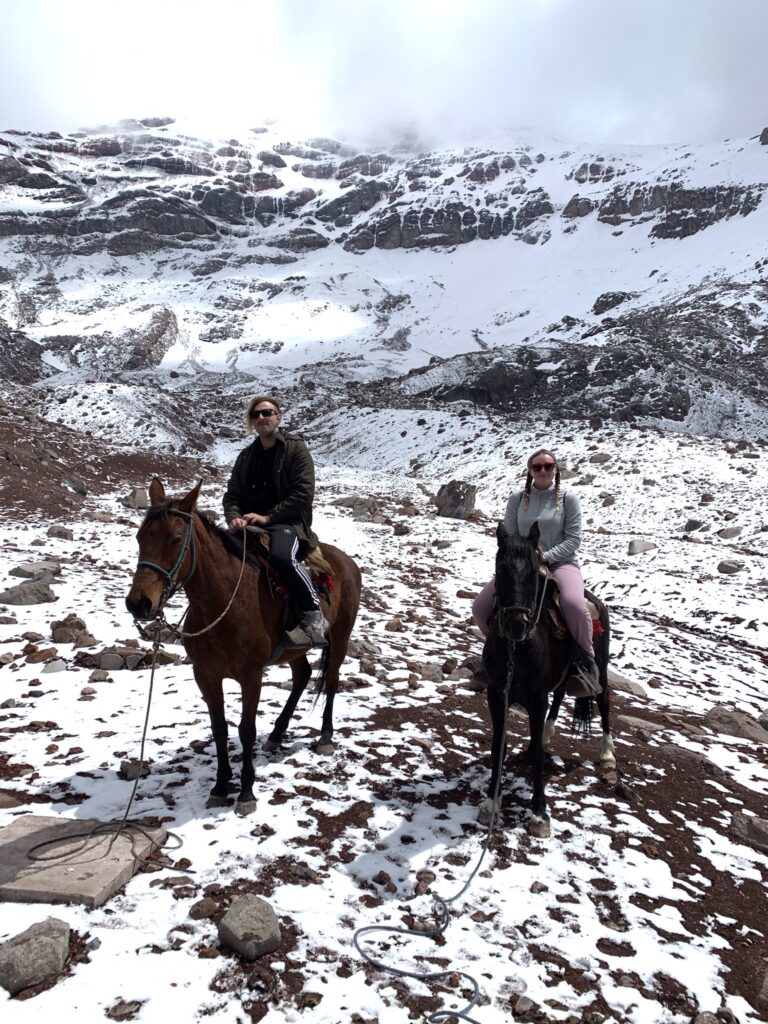
Scaling the highest volcano in Ecuador on horse-back
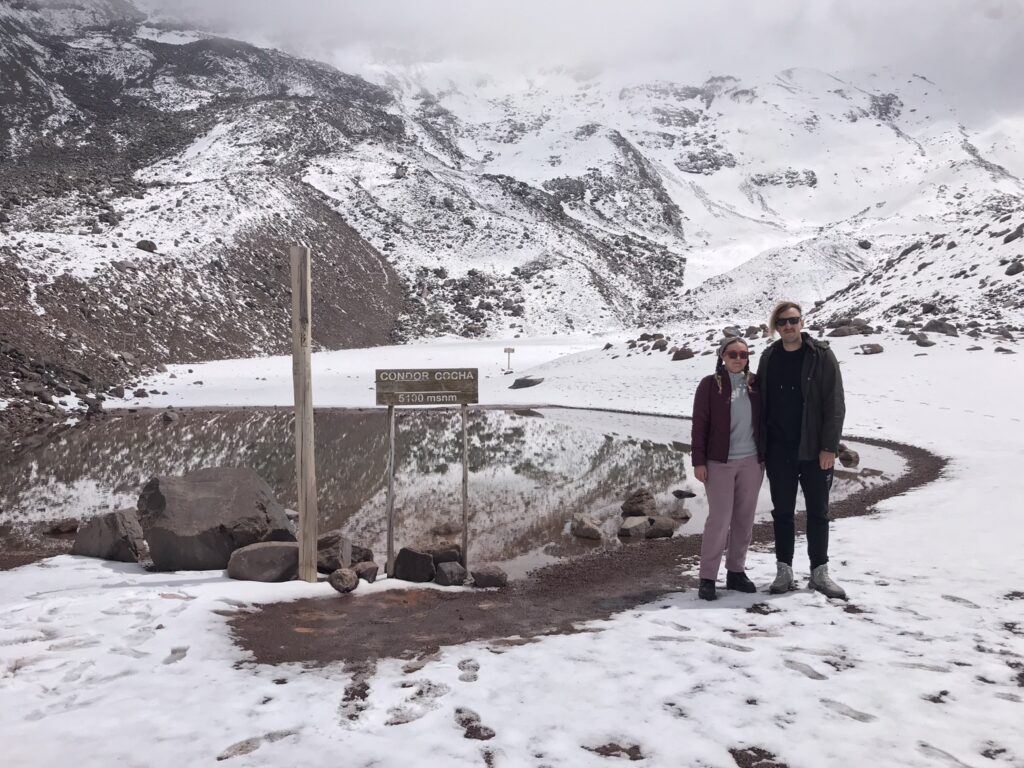
One of the furthest points from the centre of the Earth
After visiting Riobamba we wanted to head to Cuenca, however when we got to the bus station we found that there were no direct buses for hours. A local hustler told us that the best way to get there quickly would be to get a bus to Alausi and then change there for Cuenca – apprehensively, we decided to follow the advice and took the next bus to Alausi where we were dropped off at the side of the Panamerican Highway, after waiting around for nearly an hour at the side of the road and many passing buses that were going to other destinations we were eventually able to flag down a bus that was heading to Cuenca and were on our way. Alausi is a small town that was most famous for the devil’s nose train, a feat of engineering that sadly closed during the pandemic. The scenery and views from the bus around here were some of the best anywhere in South America.
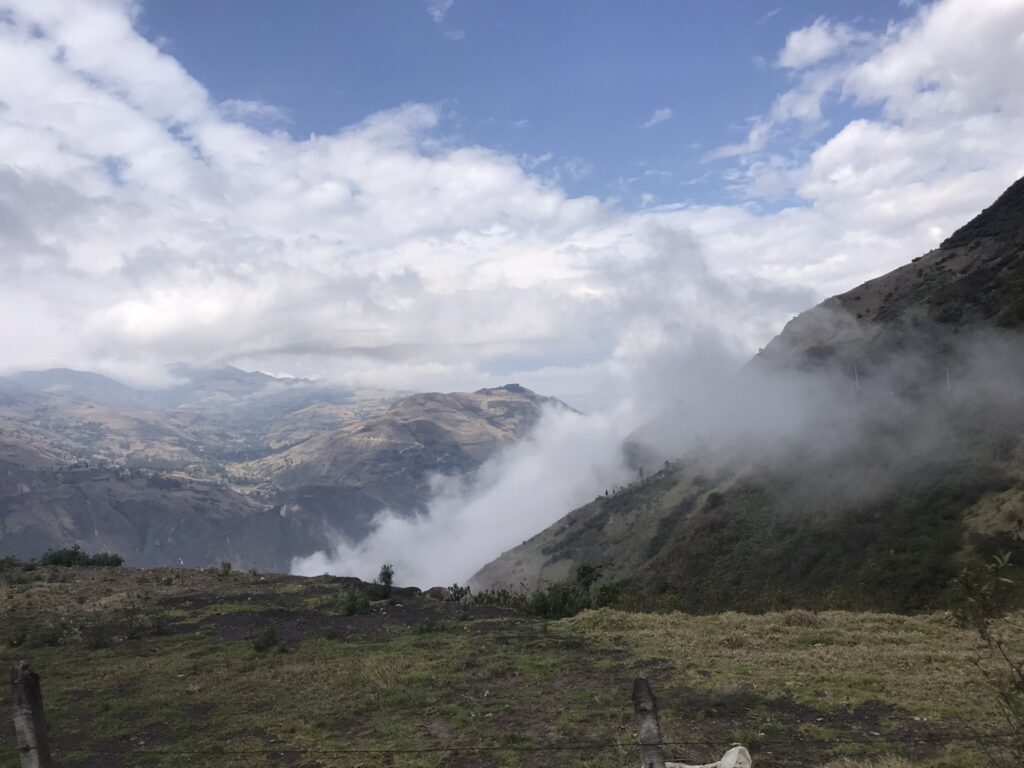
Views from the bus near Alausi
Cuenca
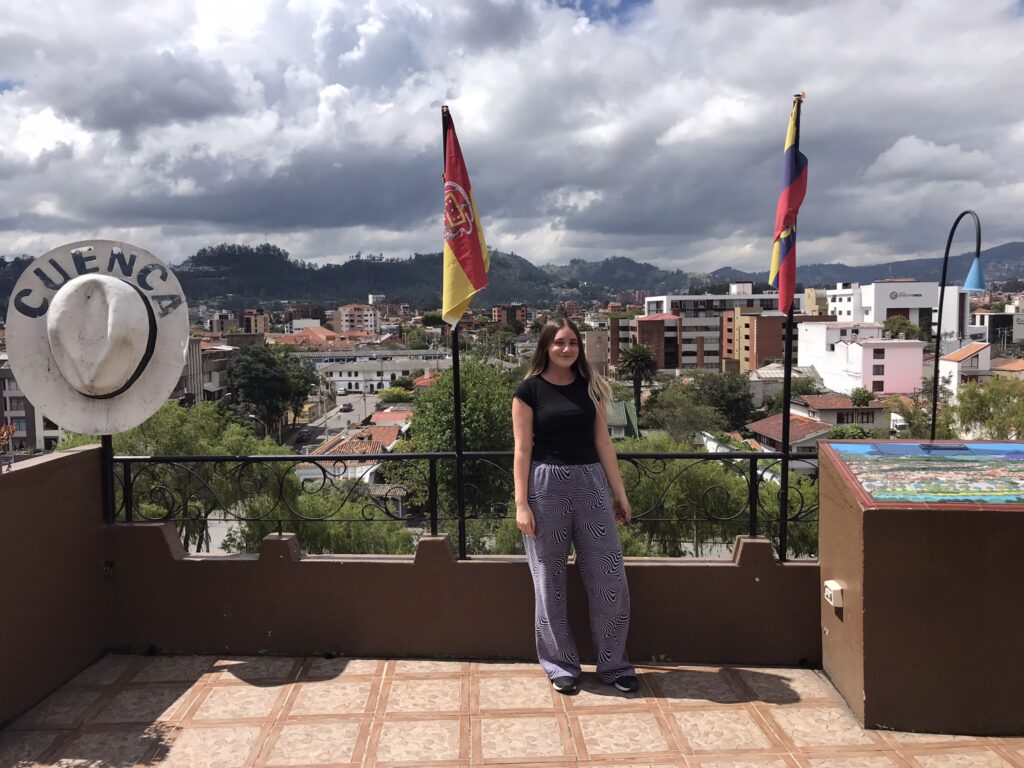
My enduring memory of Cuenca is wandering around the darkened streets looking at the Christmas lights. We visited in December and the Christmas festivities were in full-swing. One night we even stumbled upon a band performing alongside a Christmas market near a church. We got the feeling that Cuenca was more of a well-to-do place than many other cities in Ecuador, and it has quite a few American expats. When visiting Cuenca, I could almost picture myself in a historic European capital with the Spanish colonial buildings, impressive churches and general feeling of safety when walking the streets.
Accommodation
Casa Macondo Bed & Breakfast – I highly recommend this BnB, the owner was super friendly and even told us about spotting a UFO in a national park nearby.
Foodie Places
- Ni Tú Ni Yo Restaurante – I highly recommend this restaurant, the lady was very welcoming and kind, they even had UNO
- Café Ñucallacta – great food, huge portions and very cheap
- Raymipampa Restaurant – traditional Ecuadorian food, more pricey option
- Le Bistro – nice courtyard area to sit and enjoy a glass of wine and slice of quiche!
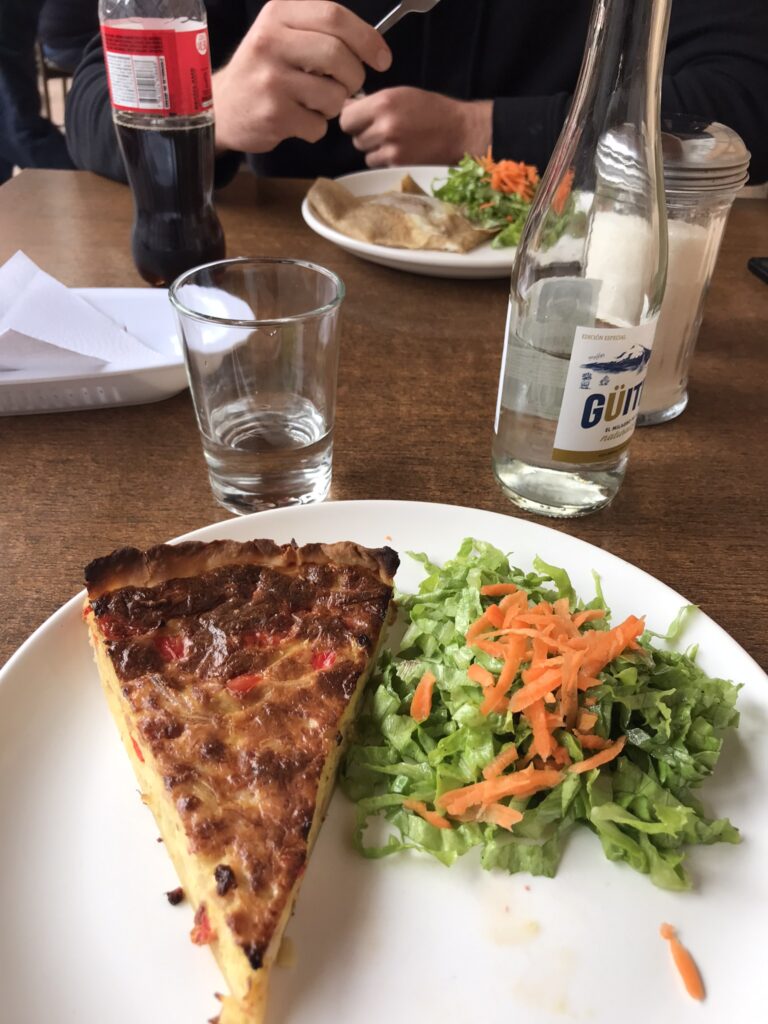
I can’t tell you how excited I was to taste quiche again after so long travelling
Activities
- Free walking tour booked through Guruwalk, including a panama hat workshop – I highly recommend as always!
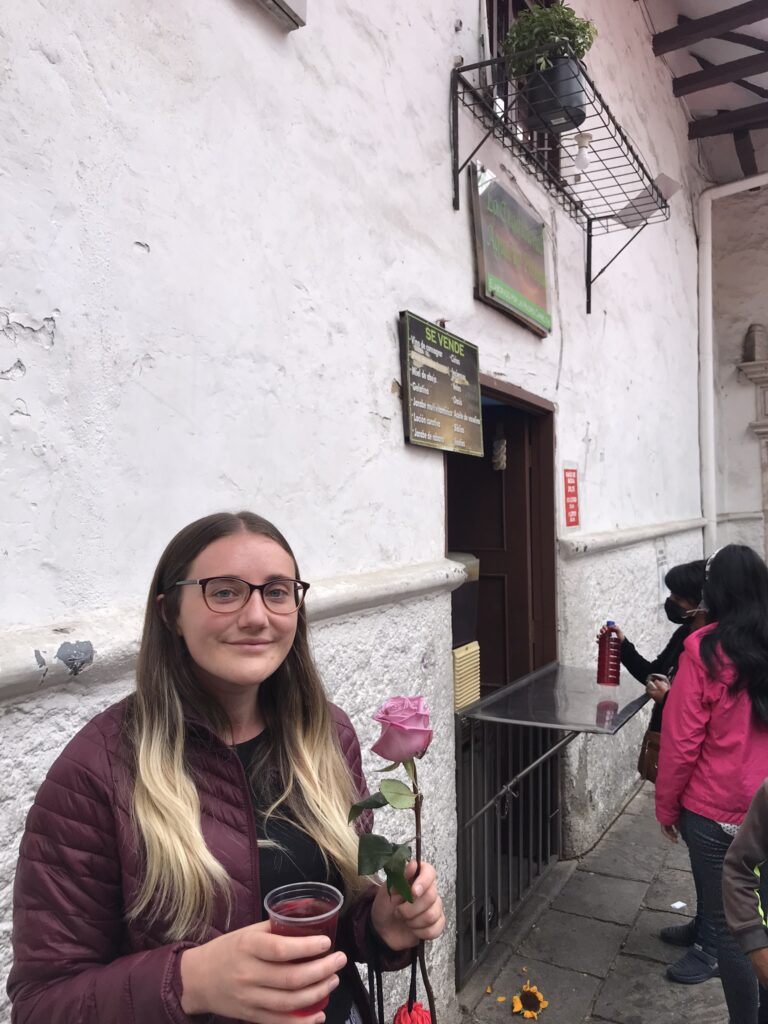
Make sure to visit the flower market and the adjacent convent selling rose water
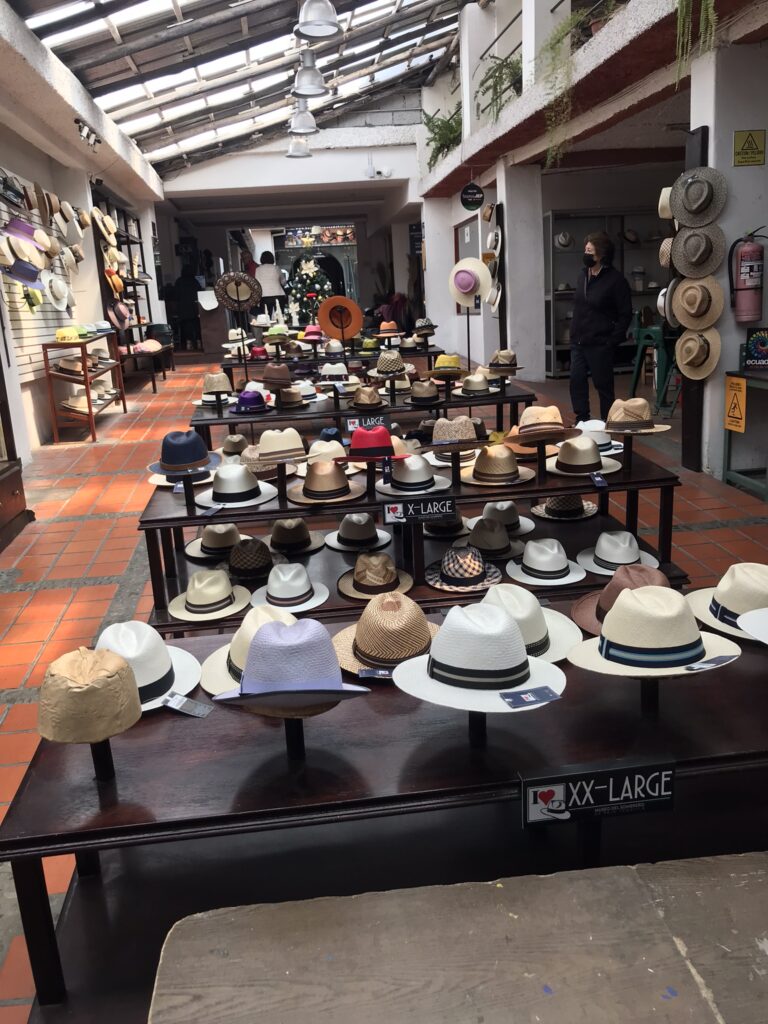
Panama hats are not from Panama!
- Group tour of Ingapirca archaeological site with a visit to Sanctuary of the Virgen del Rocio – a really interesting archaeological site, when we visited the site was almost deserted, just how I like it!
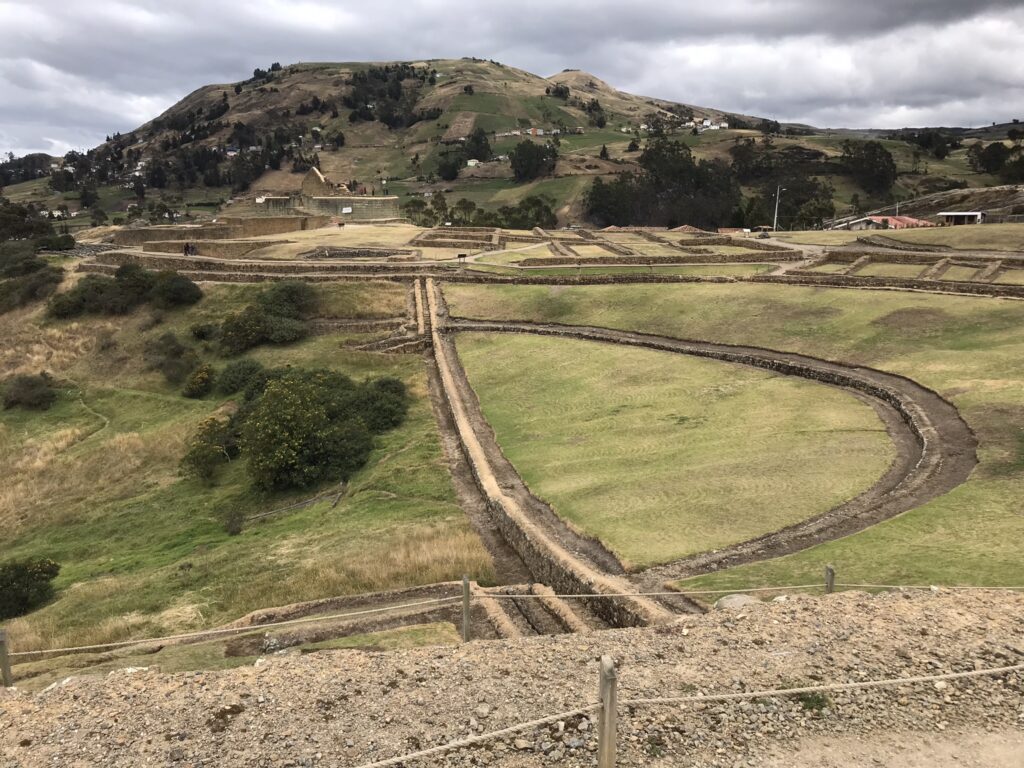
We were lucky enough to have the archaeological site to ourselves
- Museo Municipal de Arte Moderno – a quirky free art gallery in what was once a prison and children’s home.
- Museum of Aboriginal Cultures – a very memorable museum, it was a private collection and there was so much pottery jammed into one room, you could almost trip over some of the pieces, it was crammed!
- Pumapungo Museum – free museum alongside the archaeological ruins, there’s also nice garden with typical endemic plants such as corn and also a bird sanctuary, it’s 4-in-1.
Guayaquil
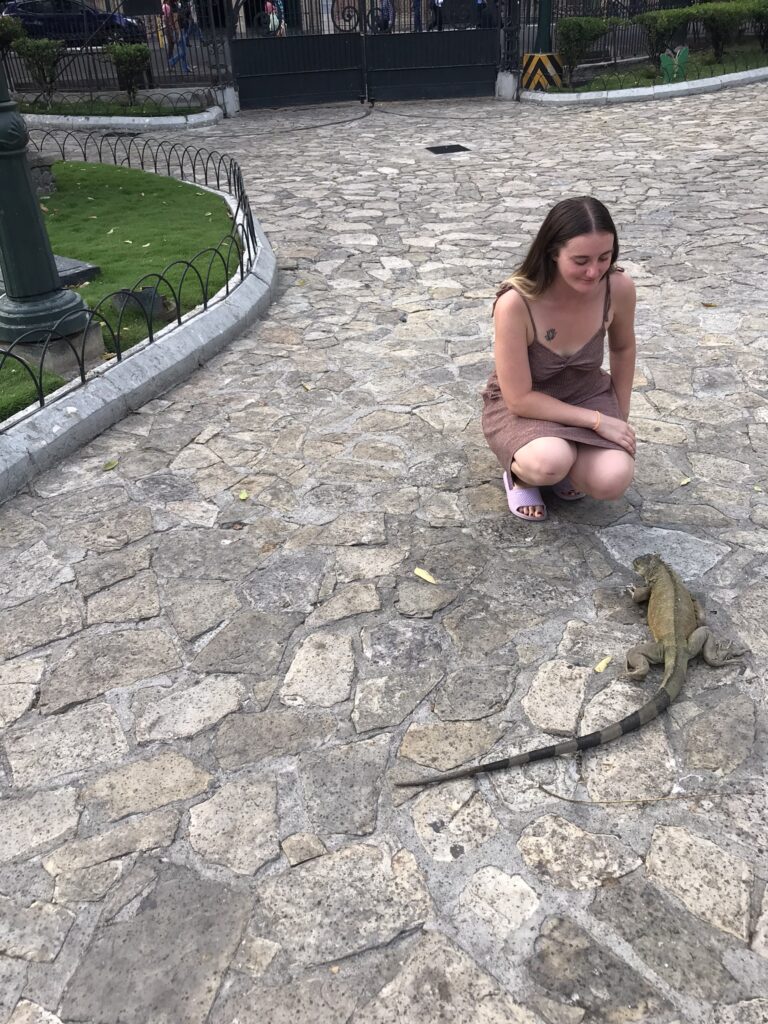
Watch your step! Park Seminario has so many iguanas it makes walking through the park almost treacherous
We didn’t find Guayaquil very warm and inviting to travellers, it’s somewhere to pass through but not to linger. There’s a lot of crime here so we played it safe and just stayed near to our hostel. We did nip out for a walk along the Malecon to eat dinner at Mercado del Rio though.
Accommodation
Manso Boutique Guesthouse – this hostel overlooks the riverfront and is next to the Malecon, it’s a good choice in a relatively safe part of town.
Foodie Places
Mercado del Río – we came here for every meal, it has a variety of street food stalls such as Peruvian, seafood, Mexican, Spanish tapas etc, great for those who can’t decide what to eat or groups who all want to eat different food together.
Activities
- Malecon 2000 – this is a tranquil haven in Guayaquil, this long walkway by the river is heavily guarded by police and contains attractions, viewing platforms and restaurants. It is a safe place to wander around, street hawkers are not allowed in here are you can literally see them peering longingly through the metal bars separating the malecon from the street. We spent almost all of our time in Guayaquil on the malecon viewing some of the sights such as the clock tower and independence monument and viewing Santa Ana hill from afar.
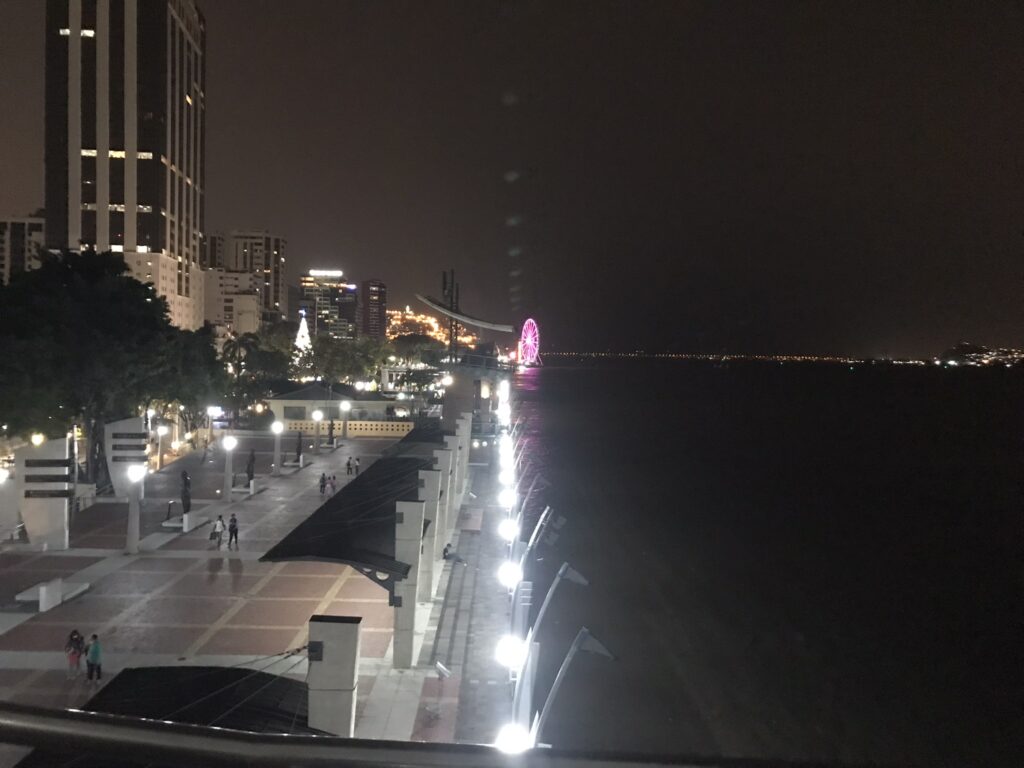
Malecon 2000 in the evening – the malecon is actually locked overnight from midnight until 7am
- Park Seminario – this park is close to the malecon and is safe enough to walk to, the park has some statues and an impressive cathedral but is mainly known for being full of iguanas!
The Galapagos
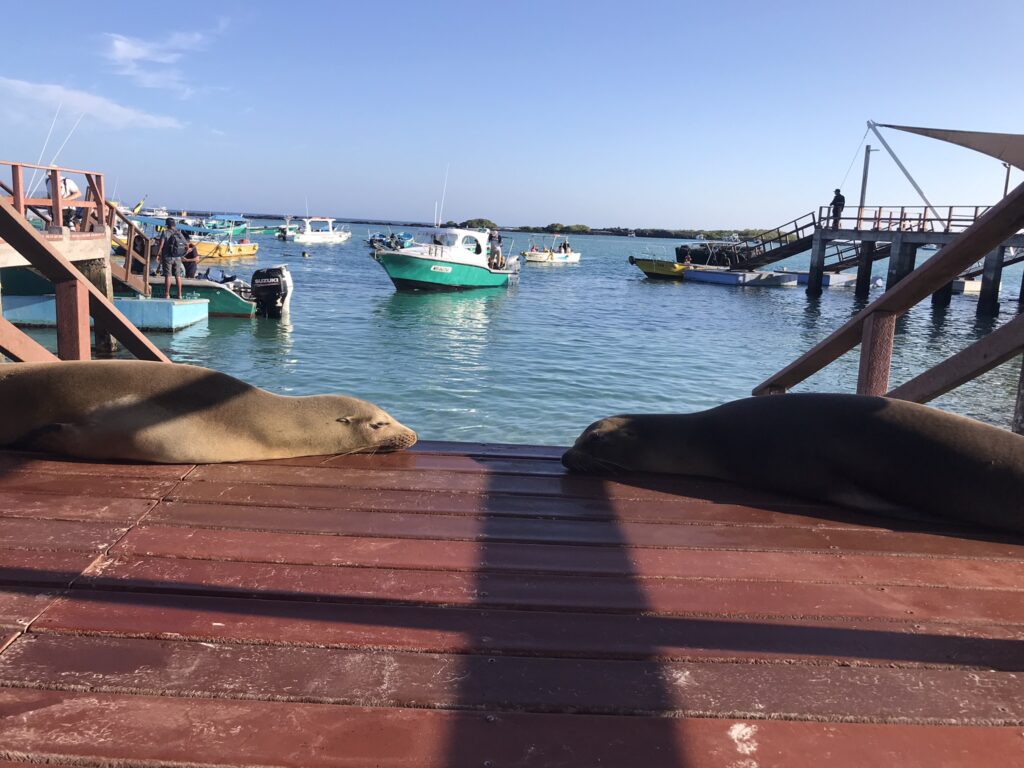
Catching rays on the dock, Isabela
One of my favourite experiences in South America was visiting the Galapagos. Wildlife co-exists harmoniously with humans on the Galapagos, you almost have to watch your feet to avoid stepping on a seal, an iguana or giant land tortoise. Wildlife really is within touching distance. We really enjoyed our short time on Galapagos, from swimming with a friendly sealion to watching turtles mating in the sea.
Can you visit Galapagos on the cheap?
A resounding hell yeah!
We spent a week on the Galapagos and arranged everything independently. With a bit of planning and organising, we were able to see pretty much all the wildlife that we wanted to see and have a great experience without breaking the bank. For my tips on visiting the Galapagos independently and on a budget, see my blog post here!
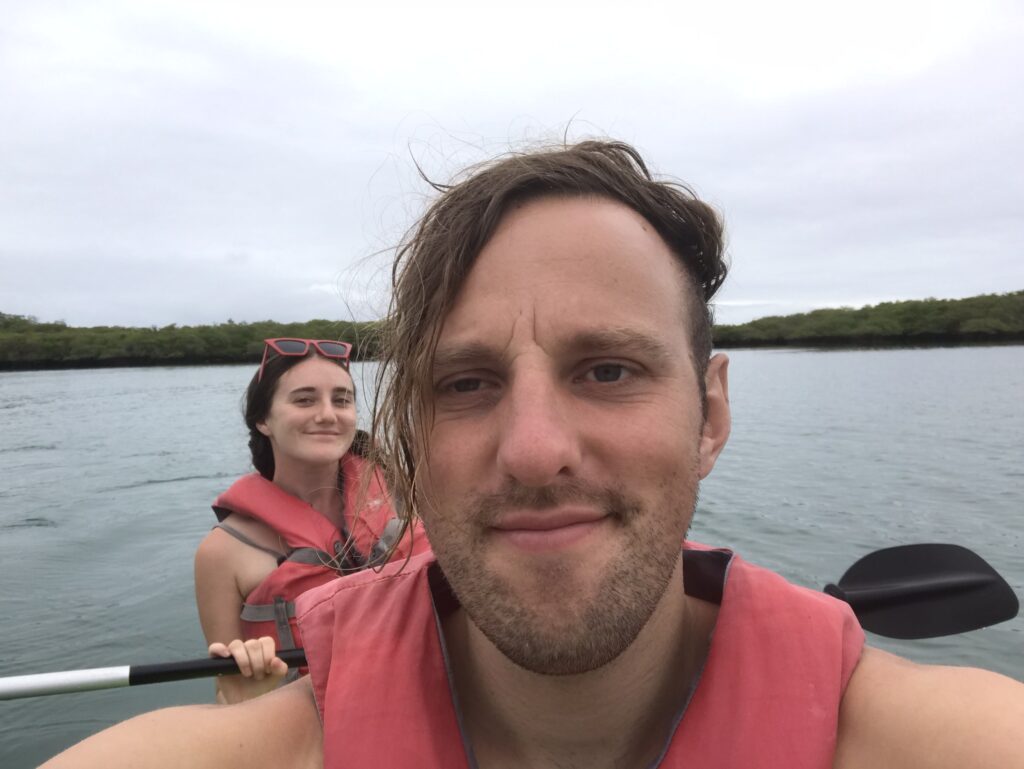
I really recommend hiring a kayak instead of snorkeling equipment at Tortuga Beach
Galapagos has many islands but only three are inhabited. Santa Cruz contains the town of Puerto Ayora which serves as the unofficial capital of the islands, the other inhabited islands are San Cristobal and Isabela. Santa Cruz and San Cristobal both have airports while Isabela can only be accessed via boat from Santa Cruz. We chose to fly to Santa Cruz and stay on both Puerto Ayora and Isabela (at its only settlement, Puerto Villamil), we didn’t visit San Cristobal but didn’t feel like we missed out as most visitors say that it is pretty similar to Santa Cruz.
People may get the impression that the Galapagos is an island paradise, but this isn’t the case. Although it does have some beautiful and pristine beaches, the Galapagos islands for the most part are actually a barren and at times even frightening-looking landscape. The first explorers to arrive at Galapagos were terrified and thought they had found ‘hell on Earth’ due to the strange, desolate landscapes and high presence of sea iguanas. So while it is possible to laze on the beach sipping coconuts in the sun, that isn’t what the Galapagos is all about at all. The abundance of wildlife and secluded and barren nature of the islands makes for a stunning and unique place.
Outside of Puerto Ayora, Santa Cruz island has a few small settlements but definitely felt like a different world to mainland Ecuador and the rest of South America. Isabela, the largest island in the Galapagos, is only accessible by ferry from Santa Cruz and felt even more isolated, secluded and barren. Just the way we like it!
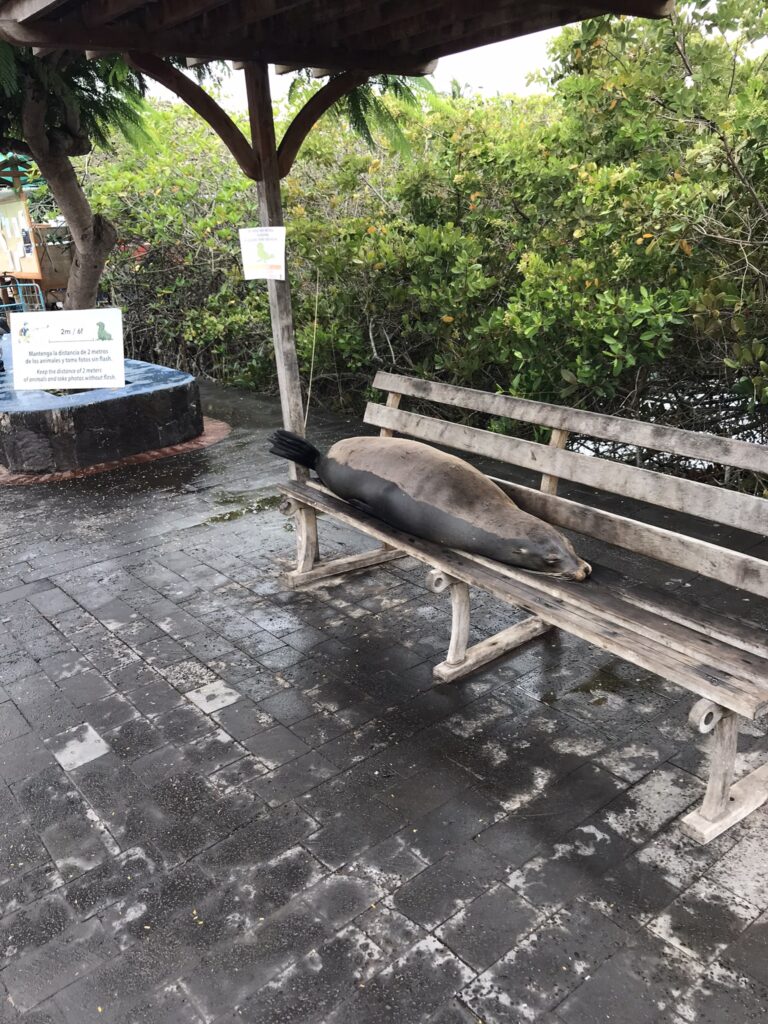
They may look cute when sleeping but they won’t appreciate tourists sitting on them
Accommodation
Puerto Ayora: Airbnb in Hostal Miconia – we had some very weird experiences here. There was no reception or checkin desk for this Airbnb-turned-hostel so when we arrived we just sort of wandered in and tried to find someone, apparently everyone on Galapagos leaves their doors open because crime is non-existent here. By knocking on all the doors we eventually found an old woman who let us into our room. After checking in we removed a key that was on the inside of the door thinking that this was just a spare key, only to discover afterwards that the key inside the door was actually a part of the locking mechanism and was super important for unlocking the door. And that by removing it we were now locked out. By the time that the lock stopped functioning the lady we had spoken to earlier had vanished. I had to break into the room, taking advantage of a missing metal bar in the grate over the bedroom window and the fact that the window didn’t lock so I could just slide it open. Safe to say, a lot of shimmying and contortion took place ending with me being unceremoniously dumped face first on the bed under the window. When we returned to the hostel after visiting Isabela the old reception lady was nowhere to be found at all, we just walked into a room that had the key in the door and no-one said anything about it. On this second visit we encountered a man who we initially thought was the owner, but he turned out to be actually scouting the place out himself to book a room, this led to a lot of confusion and a quick tour of our room. I’m not sure who he thought we were. The room was fine anyway apart from these strange occurrences, and was a good location and price.
Puerto Villamil: Hotel Neptuno – nice hostel with a kitchen.
Foodie Places
Kiosk street (Charles Binford Street) is the place to go for cheap almuerzo deals in Puerto Ayora. Almuerzo deals, elsewhere in Ecuador, are usually only offered at lunch-time however Kiosk street is the exception as they offer these deals all day. They usually offer a starter, main and drink for $5, an example menu is fish soup, fish with rice and juice. Sometimes they even include a dessert! We tried three different establishments on Kiosk street and started comparing each restaurant’s fish soup! By the end of your trip to the Galapagos you’ll be sick of fish and fish soup but it is by far the cheapest thing to eat here for obvious reasons. We also tried Laguna Beach and Cesar’s in Puerto Villamil (both offered good almuerzo deals too).

Fish soup became a daily staple with $5 almuerzo deals
Activities
Puerto Ayora
- Tortuga Bay – this can be accessed by a 40 minute walk from the centre of Puerto Ayora, along a spooky-looking path. This was the most pristine beach we found in South America, with sea iguanas everywhere. At the end of the beach was another, smaller beach in a cove with mangroves. Here you could rent kayaks, which were great for exploring the mangroves – we found this area was absolutely full of sea turtles, and even walked (or paddled) in on some mating!
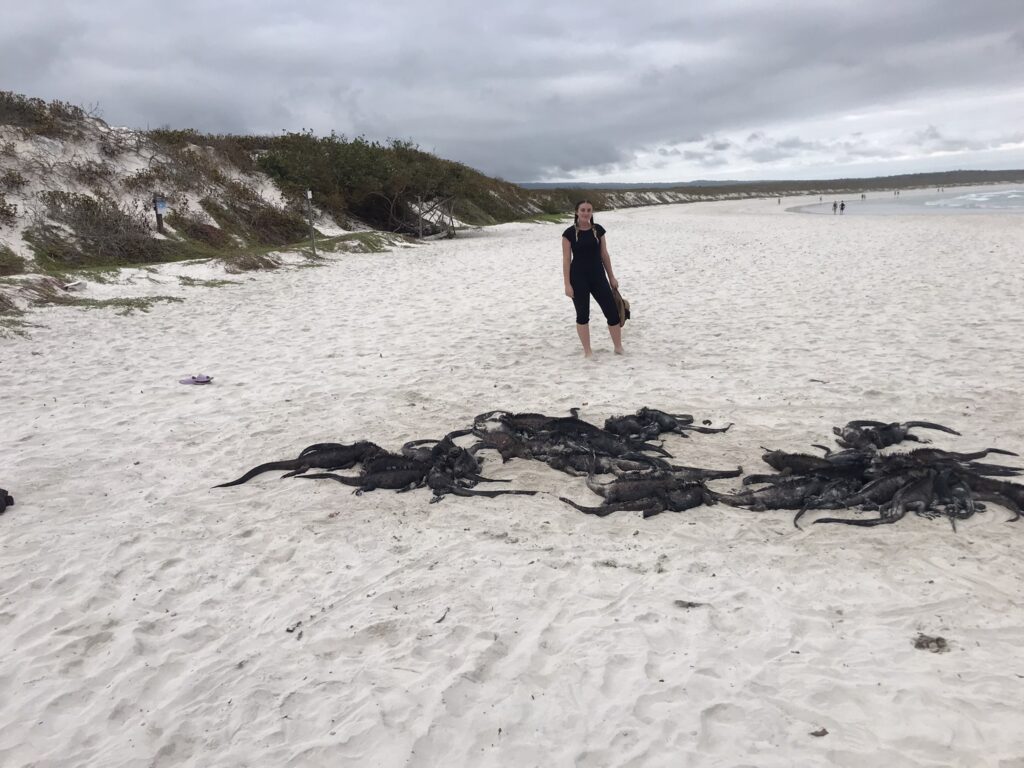
Tortuga beach – remember not to get too close to the inhabitants of the island
- Charles Darwin Research Centre – this is also easily accessible on foot from the centre of Puerto Ayora. This is a breeding area mainly for the famous giant Galapagos tortoises. Like many attractions on Santa Cruz, it was only possible to enter as part of a group with a guide who was waiting at the entrance. The guide walked us round the facility and provided a lot of information on the conservation and behaviour of the tortoises. Here it is also possible to visit the taxidermied carcass of the famous Galapagos tortoise, Lonesome George.
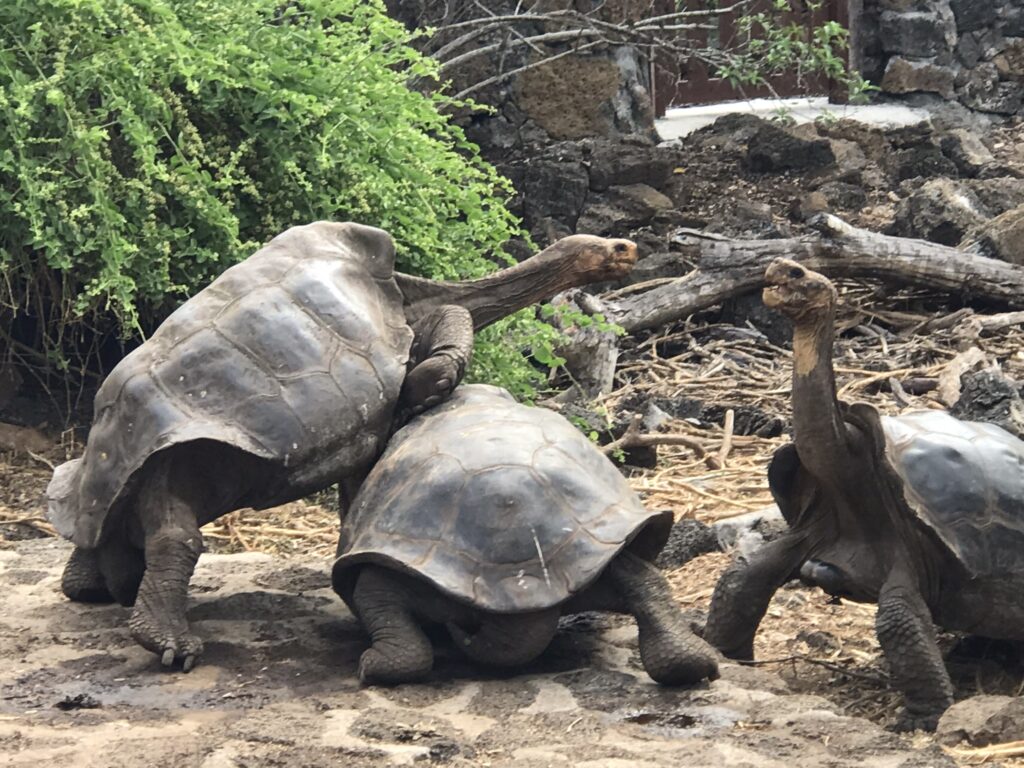
Giant tortoises fighting it out at the Charles Darwin Research Centre
- Puerto Ayora fish market – this is an attraction in itself as the small market is teeming with cheeky sea lions and birds trying to get at the fish.
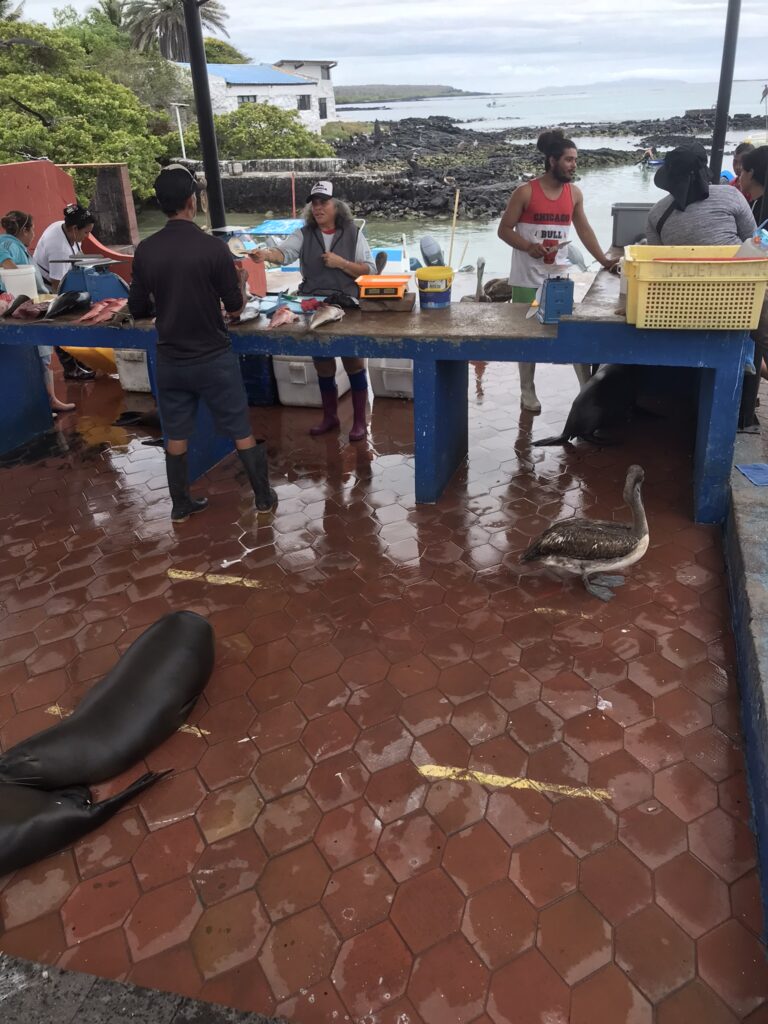
The fish market on the seafront is one of the best places to visit in Puerto Ayora if you want to see wildlife
- Las Greitas – this famous snorkeling area is only accessible by boat, and at the site entrance it is only possible to enter as part of a group with one of the guides. The main attraction is a canyon-like rock formation which is full of exotic fish, a great snorkeling experience.
- Rancho Primicias (Giant Tortoise Reserve) – located towards the north of the island, from Puerto Ayora you will need to take a taxi, you can arrange for a taxi driver to wait for you while you visit. The reserve has many huge giant tortoises in the wild and also contains an underground cave area.
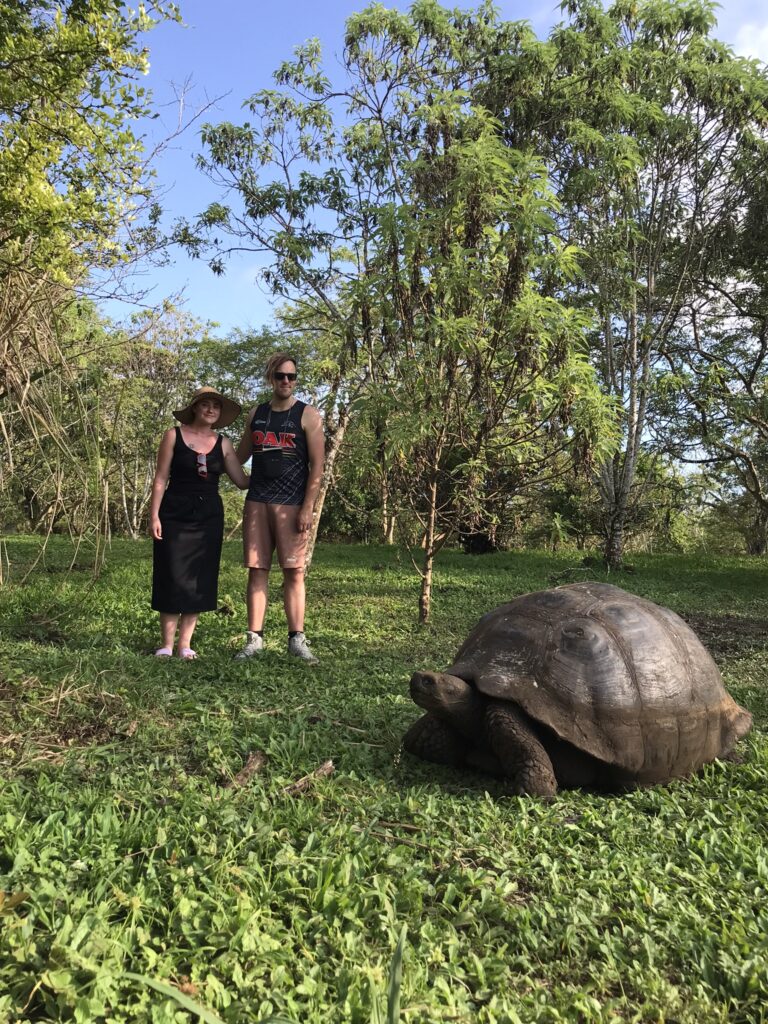
- Los Gemelos – this is a large crater that can be visited in conjunction with the Giant Tortoise Reserve as the two are located fairly close to each other. There is a path around the crater which is impressive in itself, apparently this is also a great place for birders.
Puerto Villamil
- Concha de Perla – this snorkeling area is free and a great place to see fish and marine life. We even swam with a playful sea lion here.
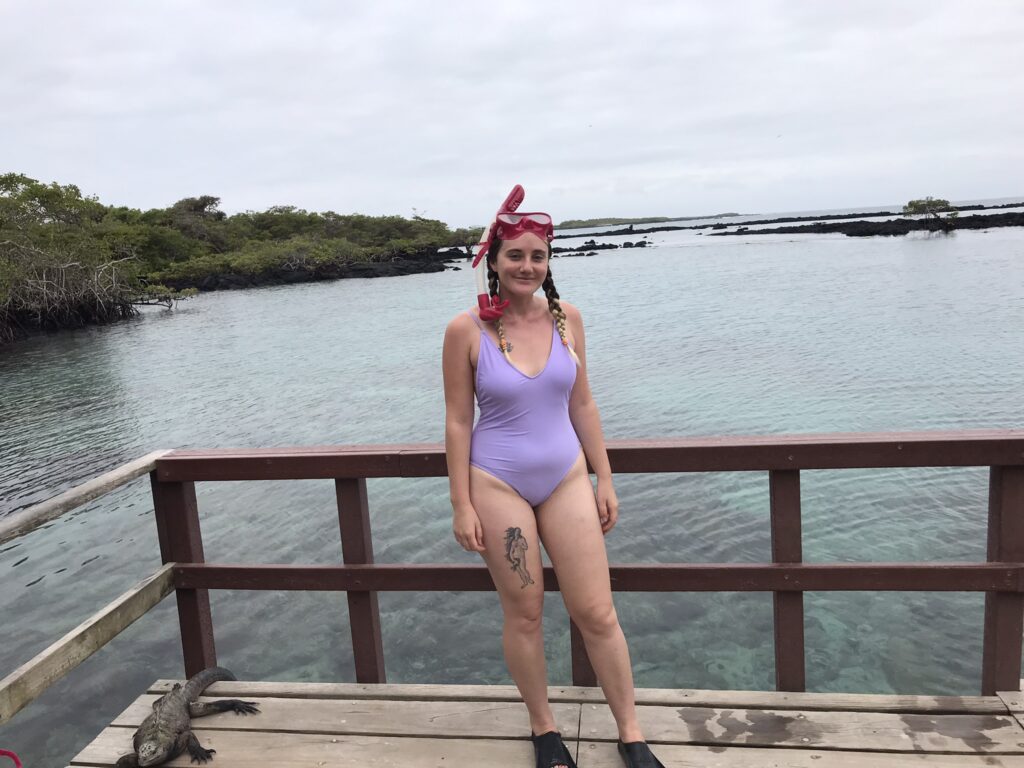
Ready for action at Concha de Perla
- Hike to the Wall of Tears – this walking trail on the West side of town takes in many interesting sights, culminating in the Cerro Orchilla which provides great views across the island and then the Wall of Tears, a sad remnant from Isabela’s time as a penal colony.
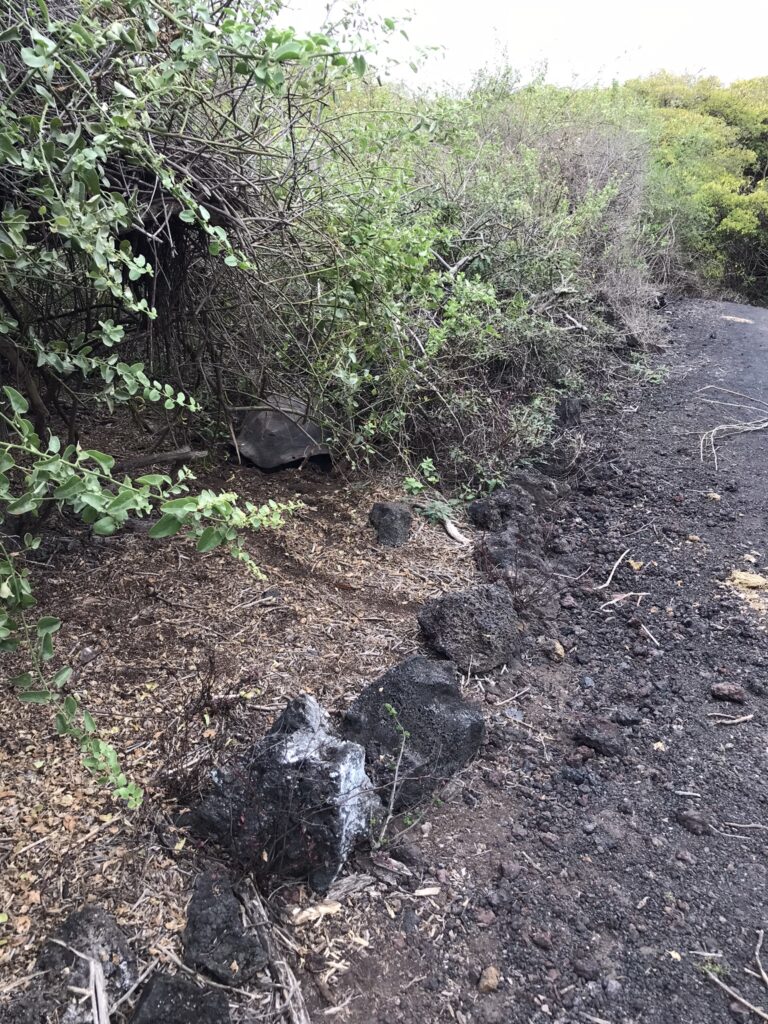
Spot the wild tortoise
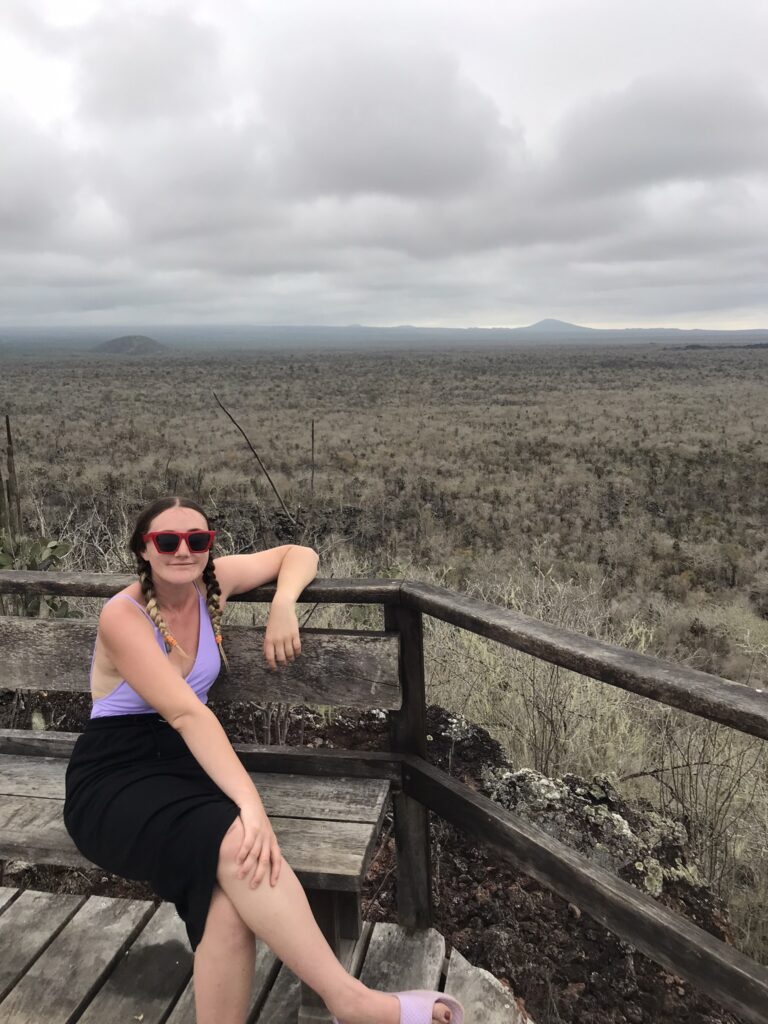
The landscape itself was a surprise. The description ‘hell on Earth’ actually suits the Galapagos.
- Snorkeling tour to Tintoreas – we tried to avoid expensive trips during our time on the Galapagos but splashed out on a snorkeling trip to Tintoreas. This was definitely worth it as we saw a huge variety of marine life, swam with sharks and even saw a seahorse!
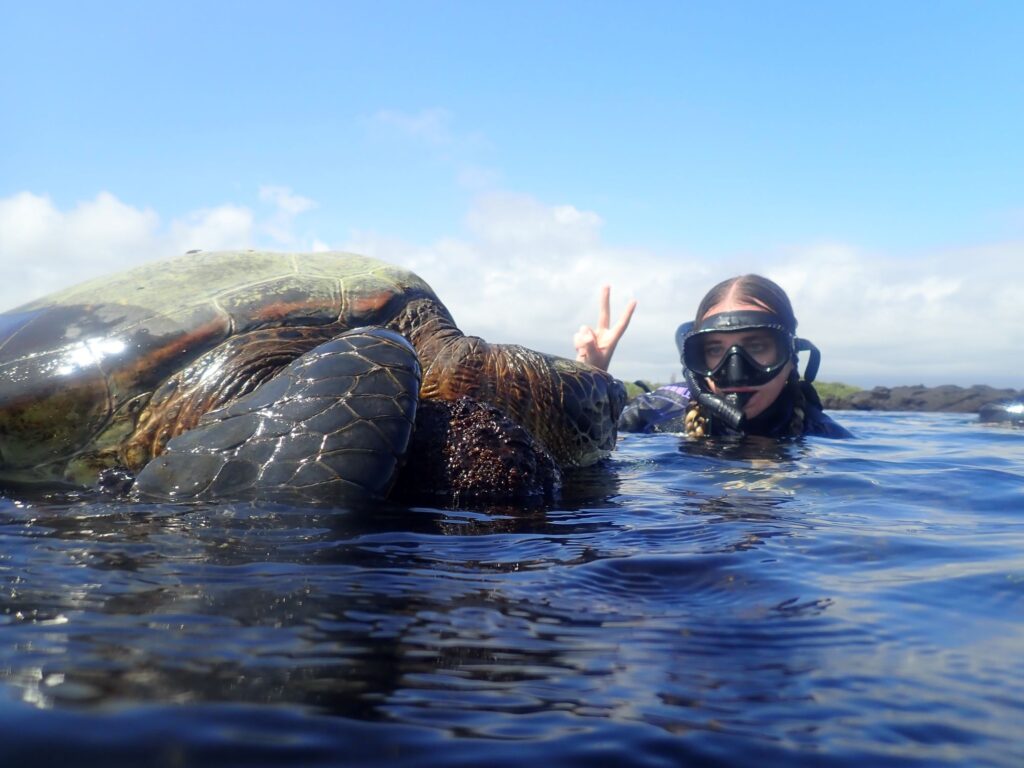
What a shot!
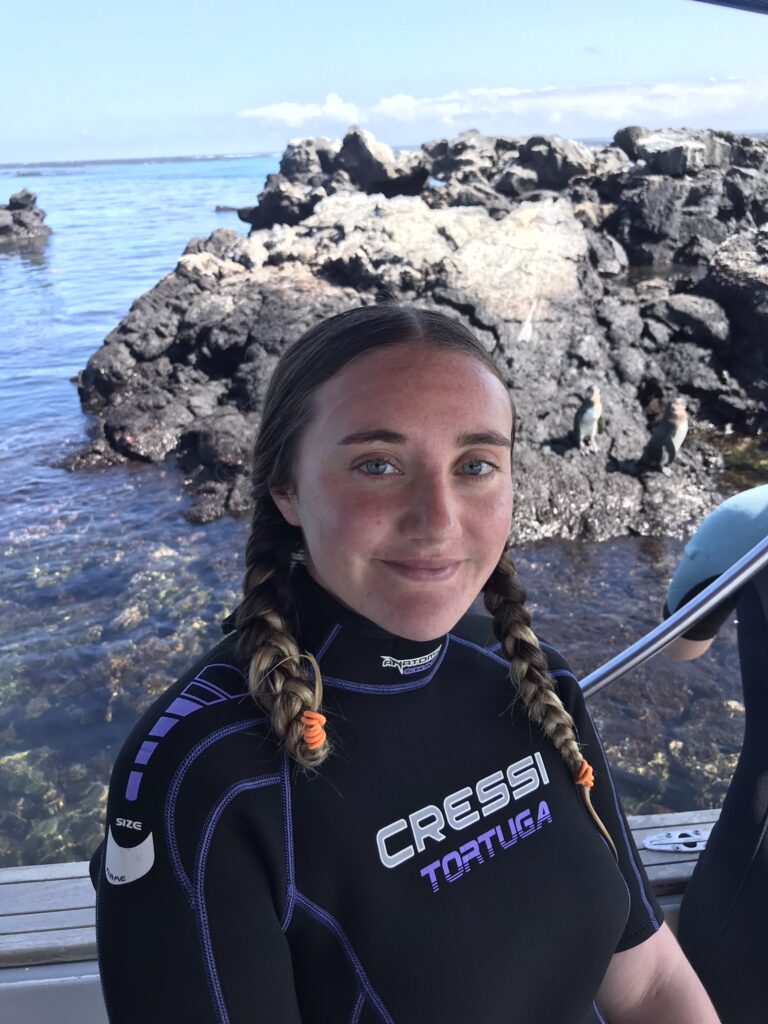
Photobombed by penguins
- Posada de Flamengos – this is a small pool located on the main road just north of town next to some sort of industrial plant. There isn’t much around, but it’s a good place to see pink flamingos.
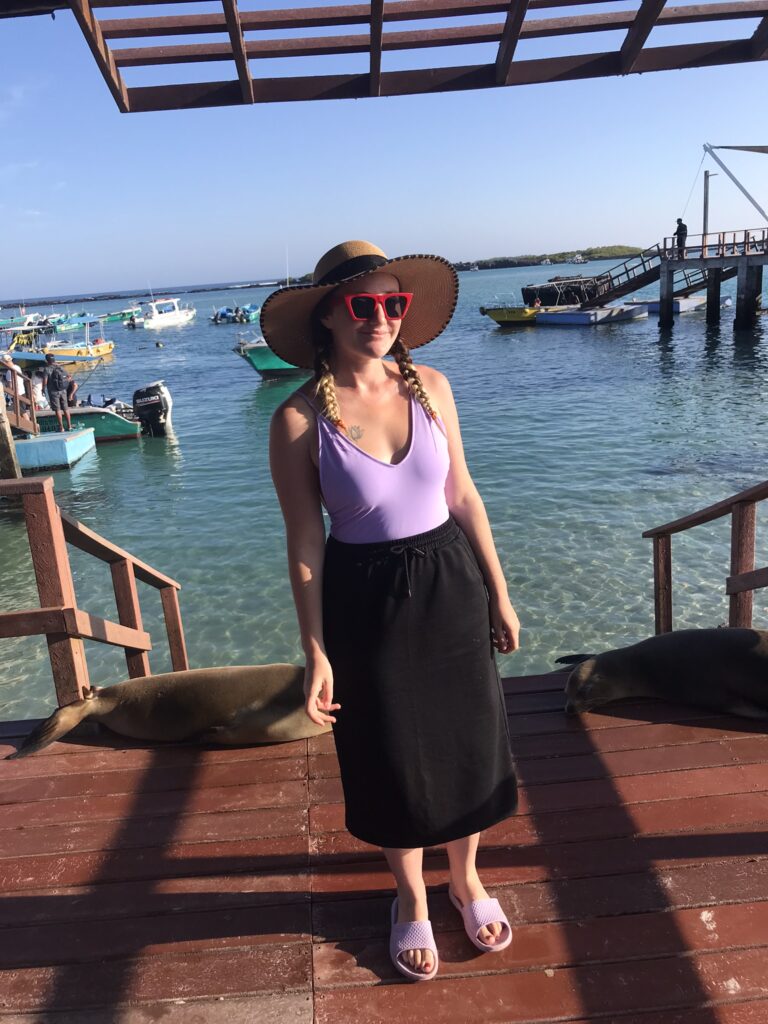
On the docks, Isabela
I wanted to share our 7-day Galapagos budget itinerary, based on our own experiences. Check it out here!
